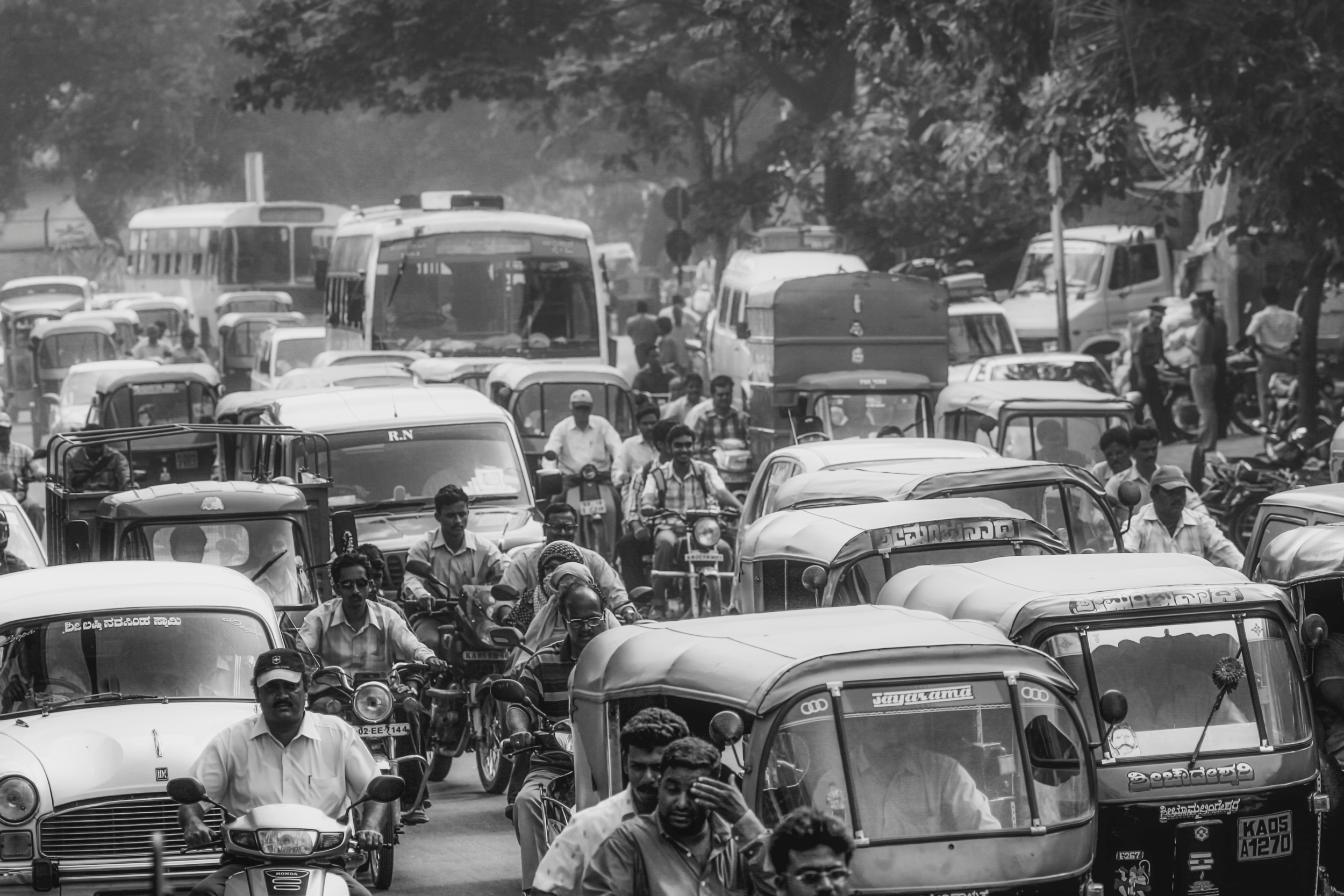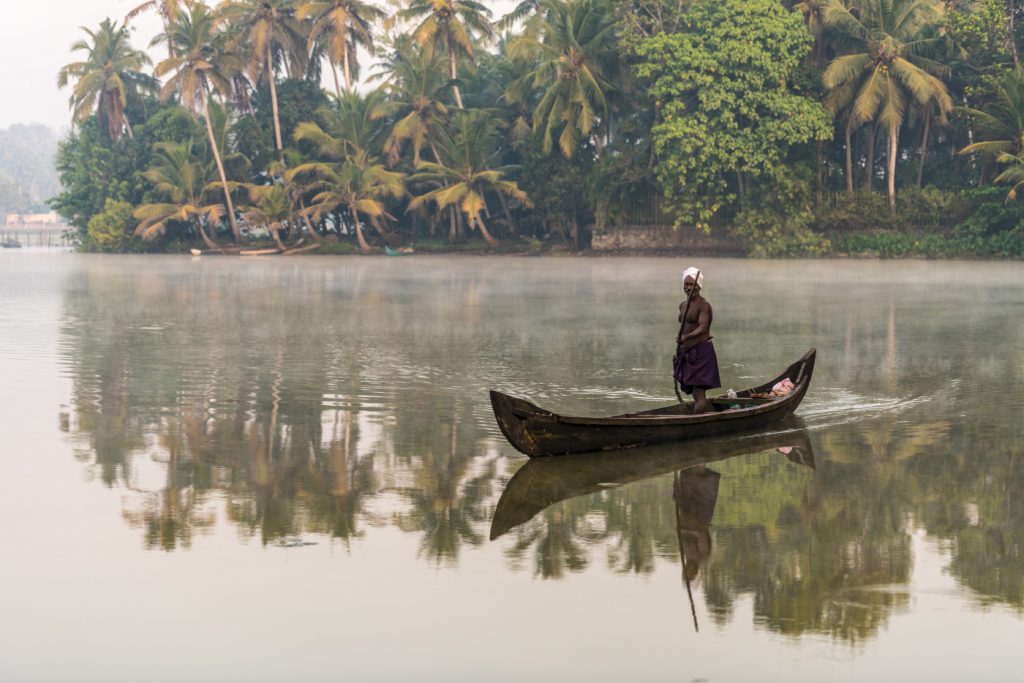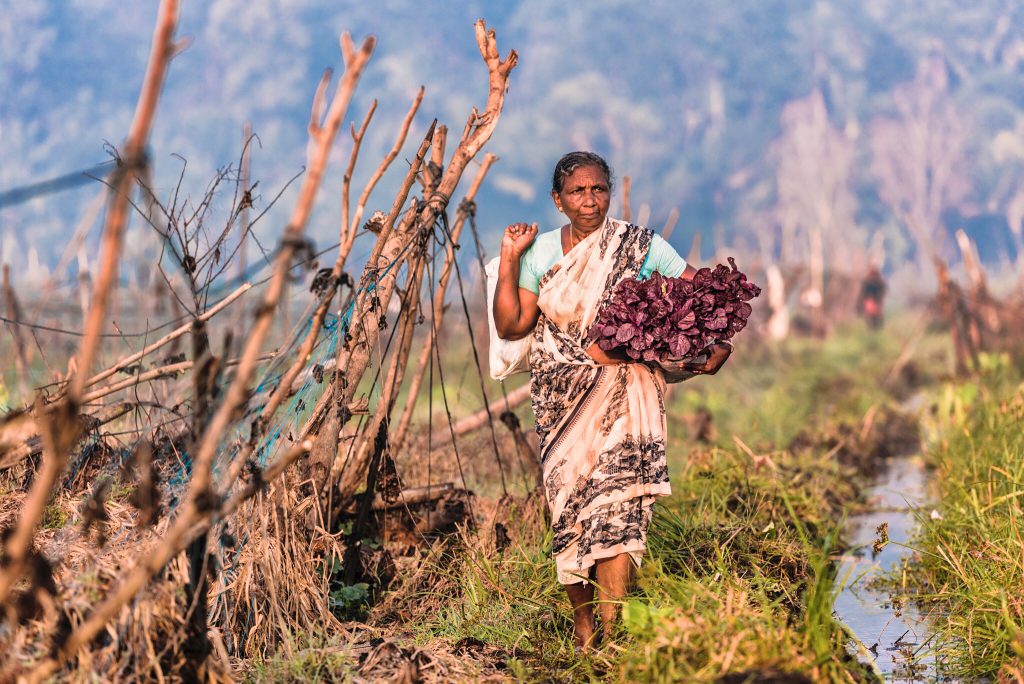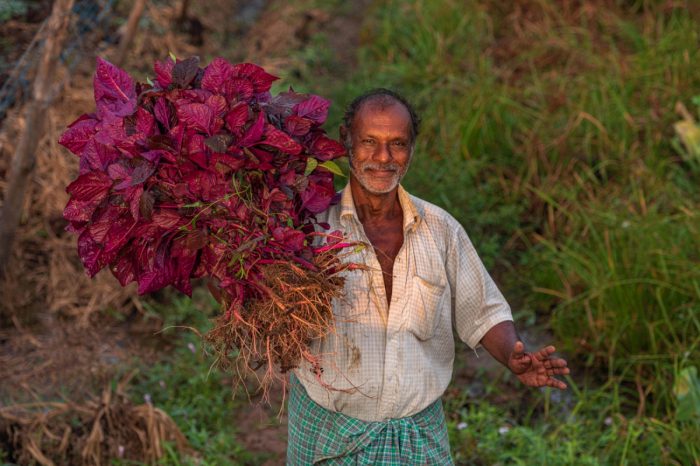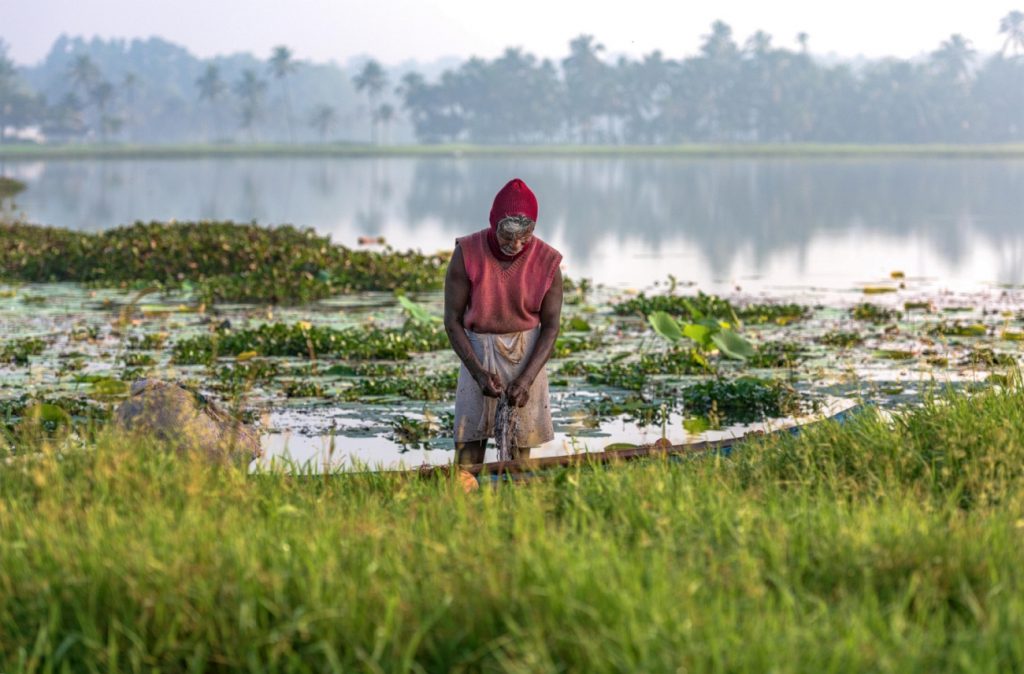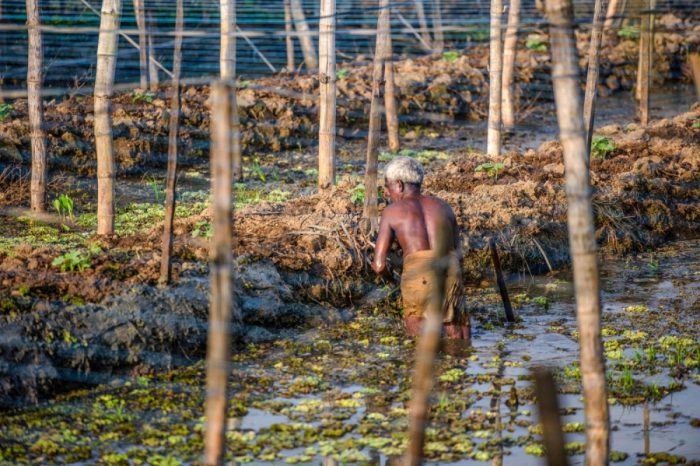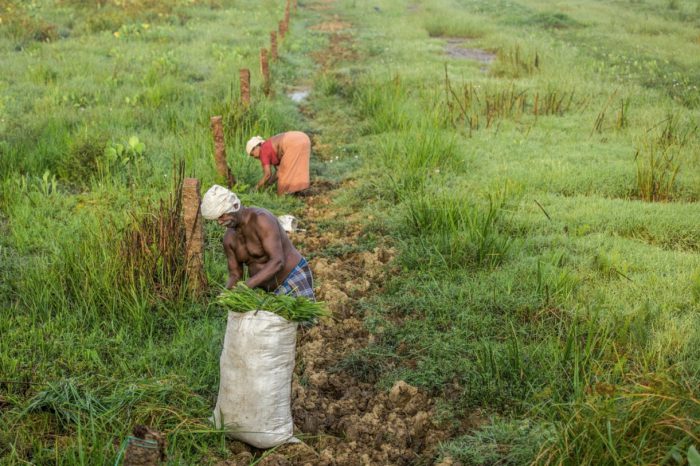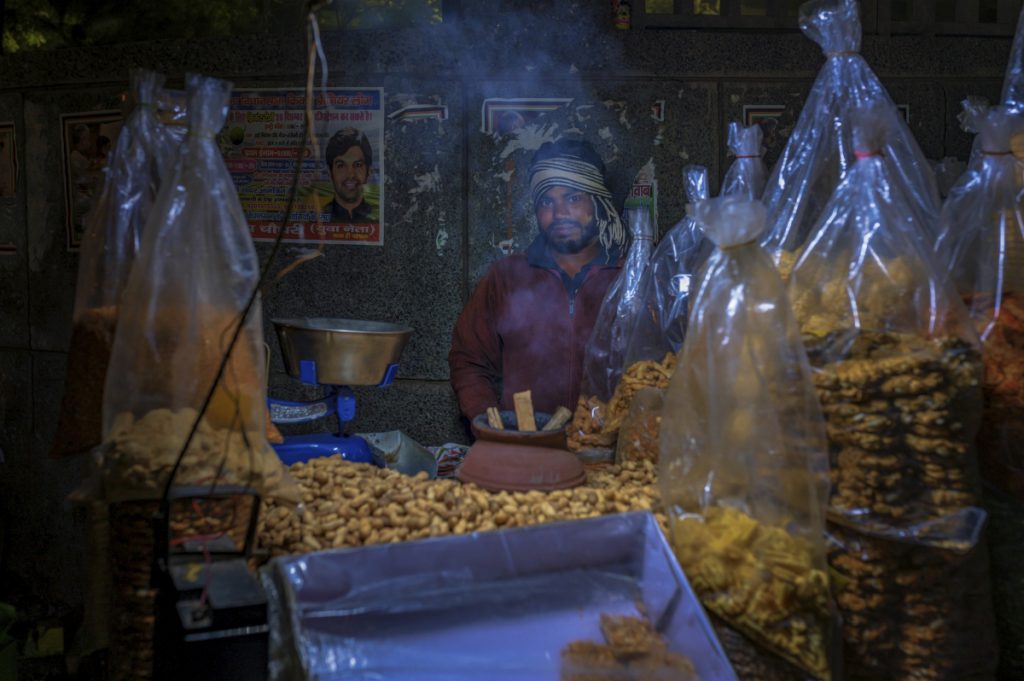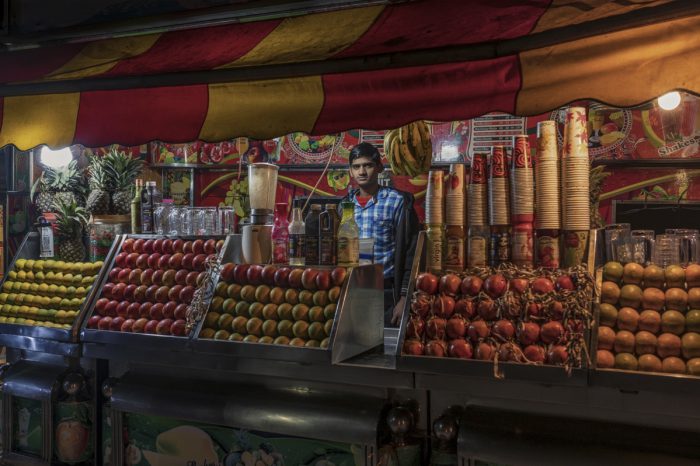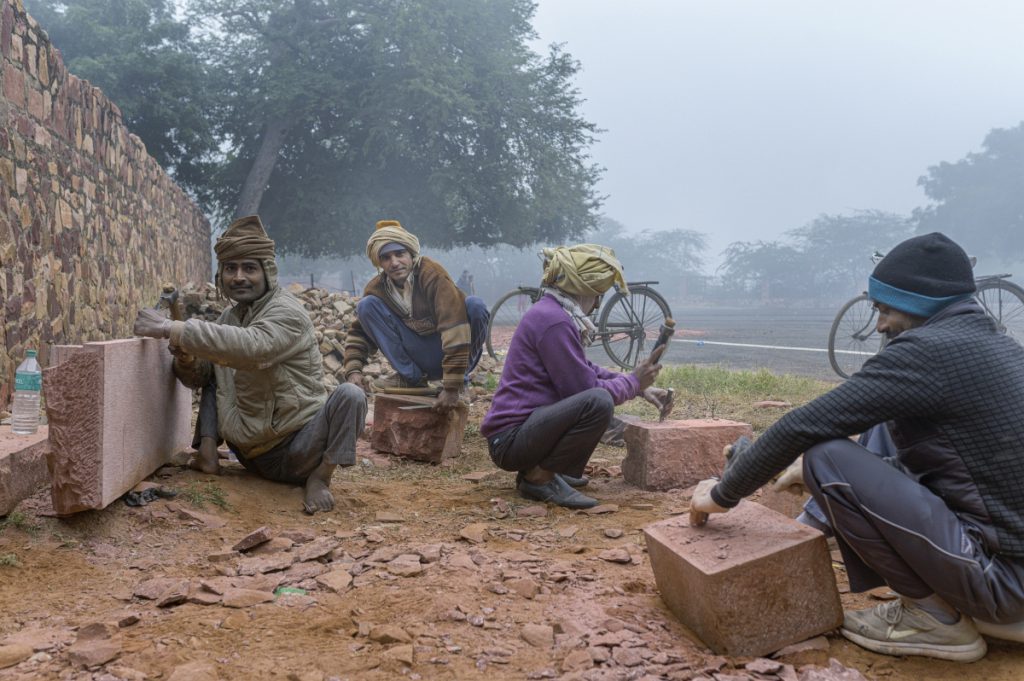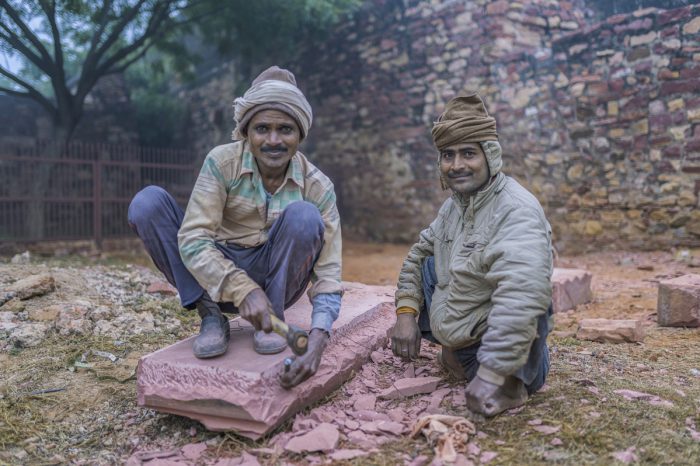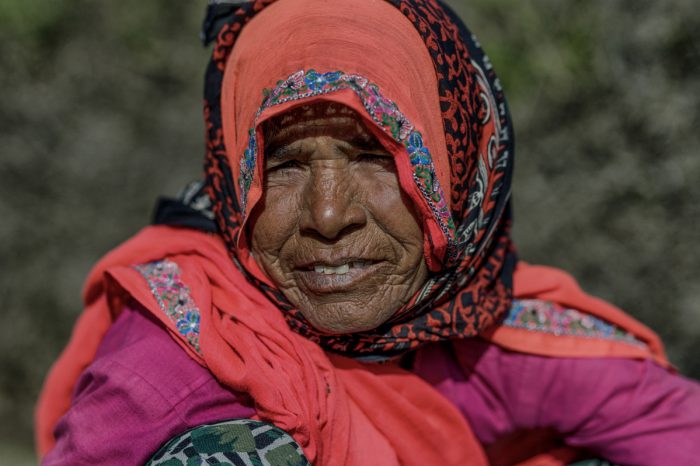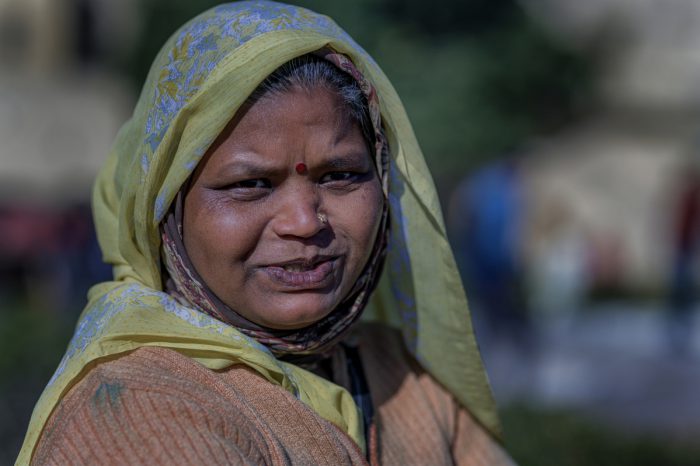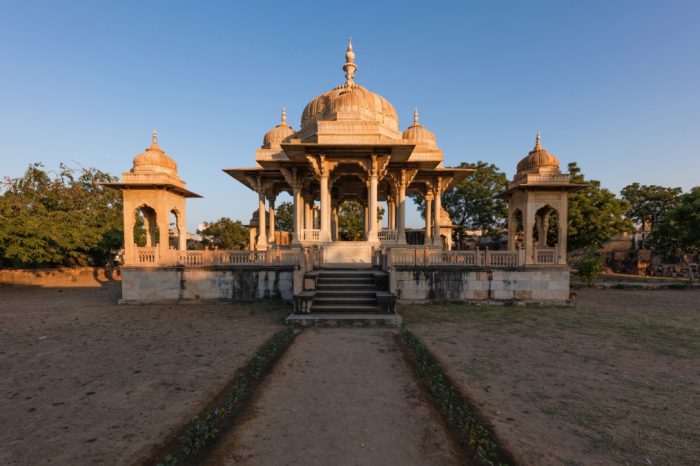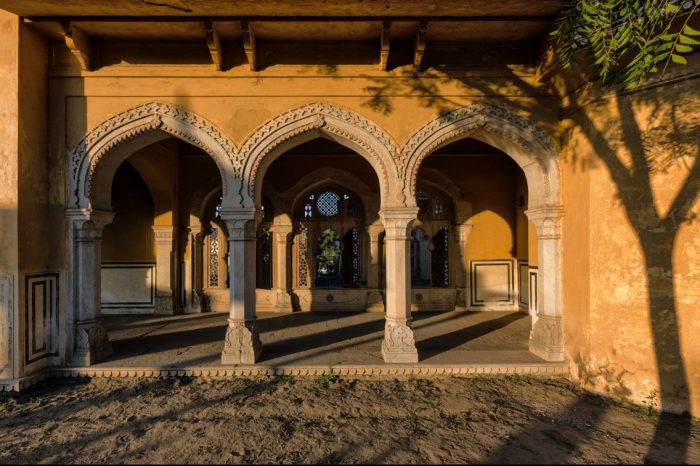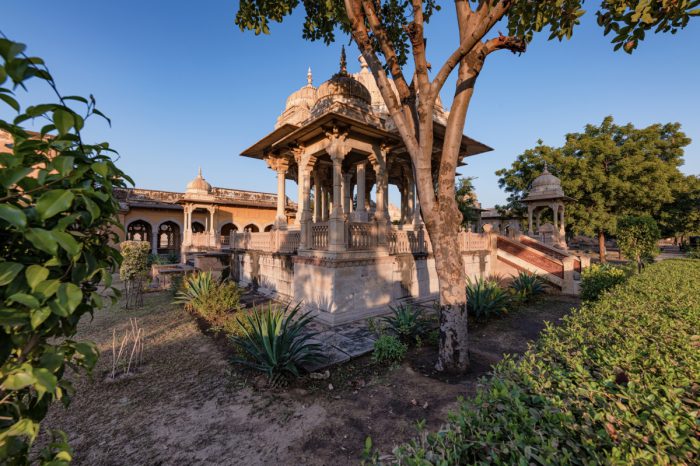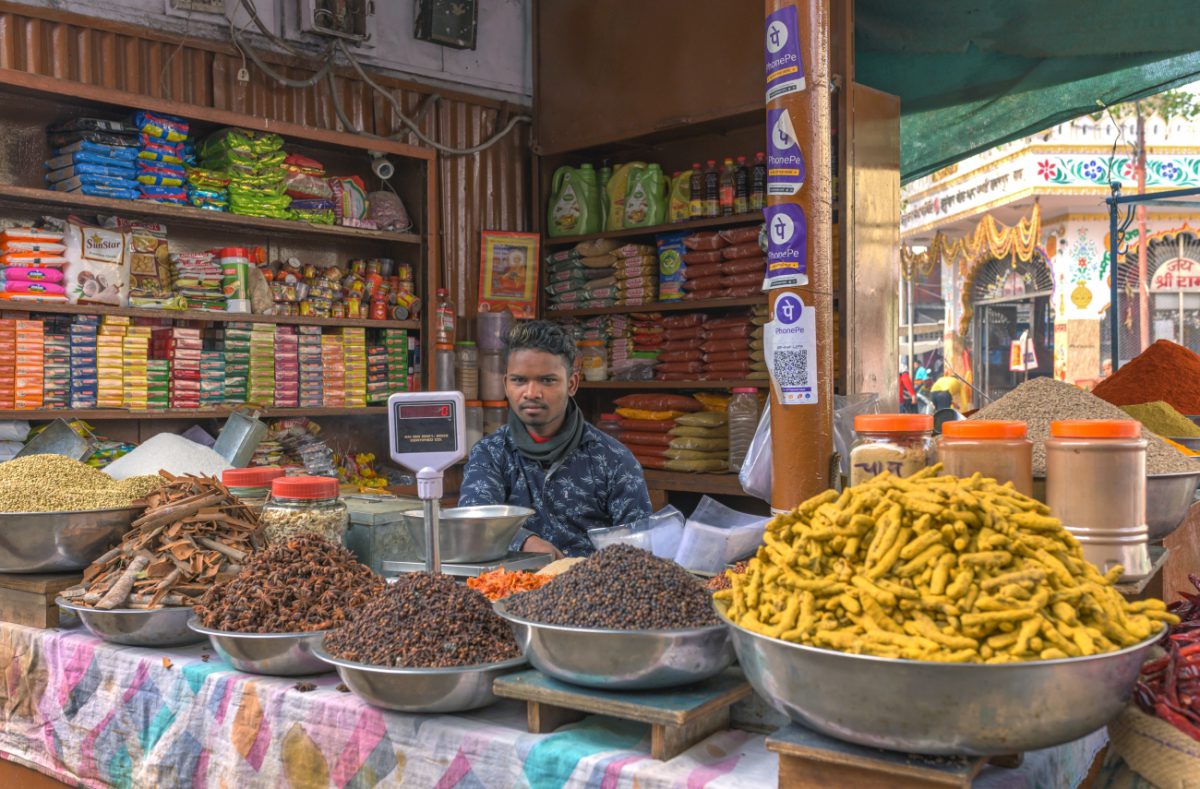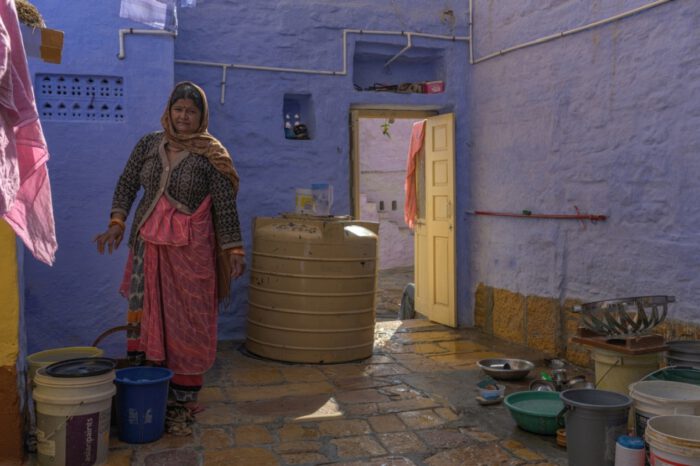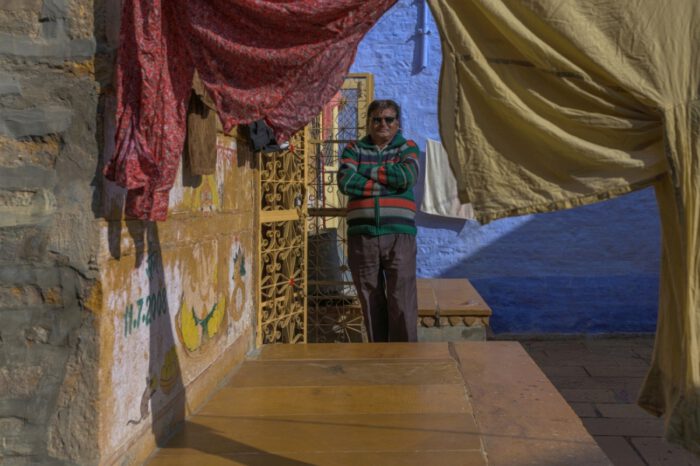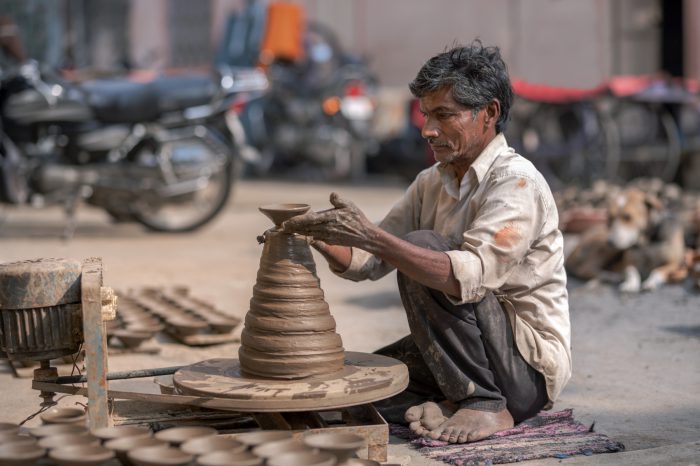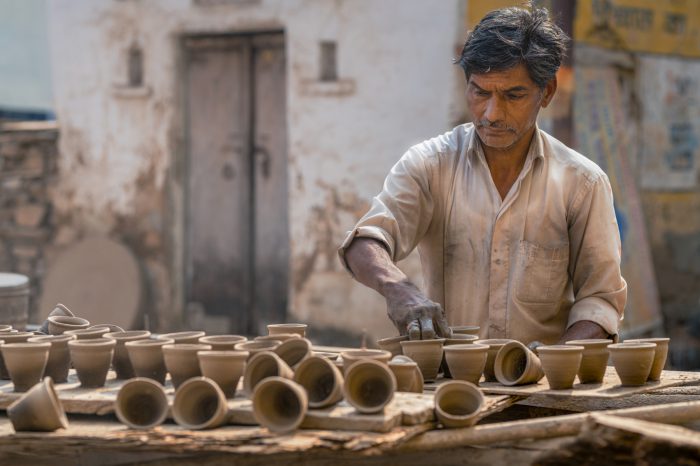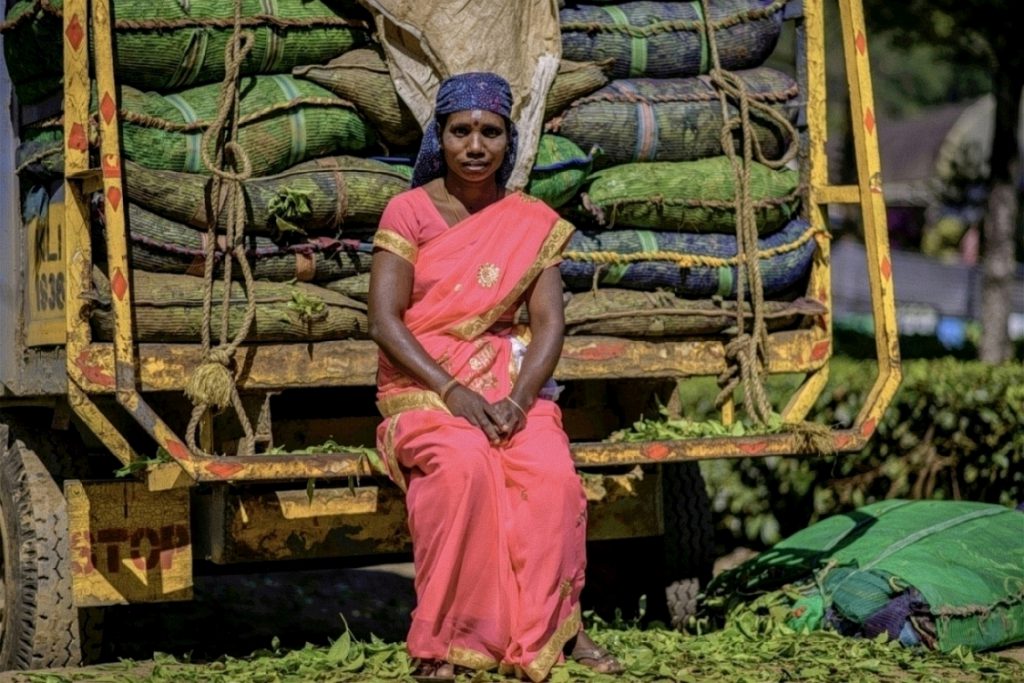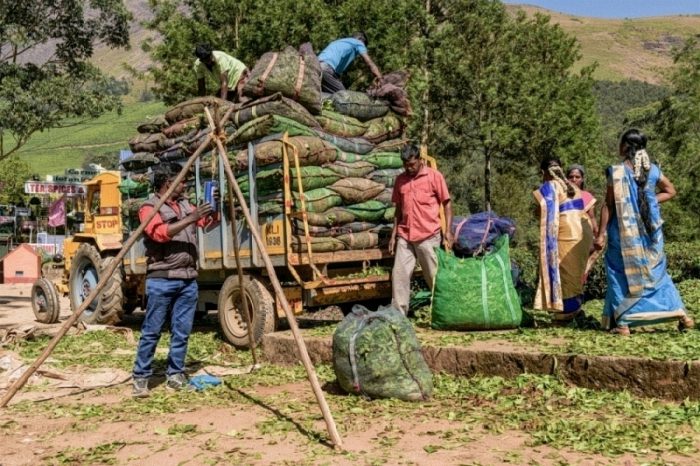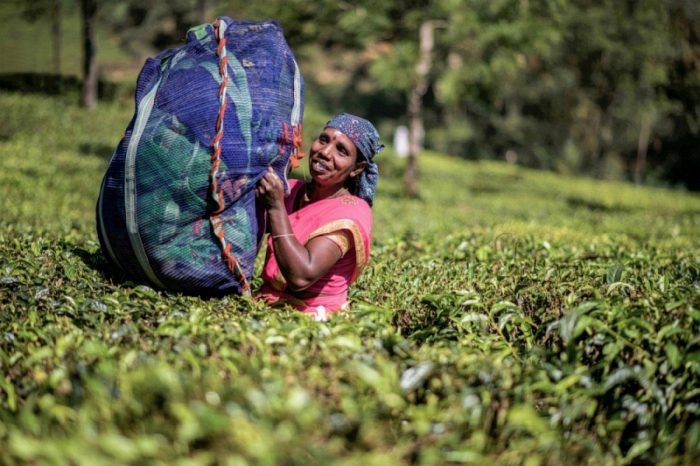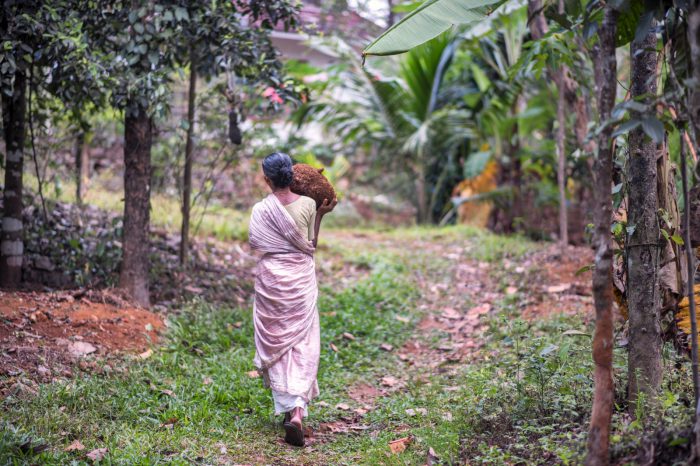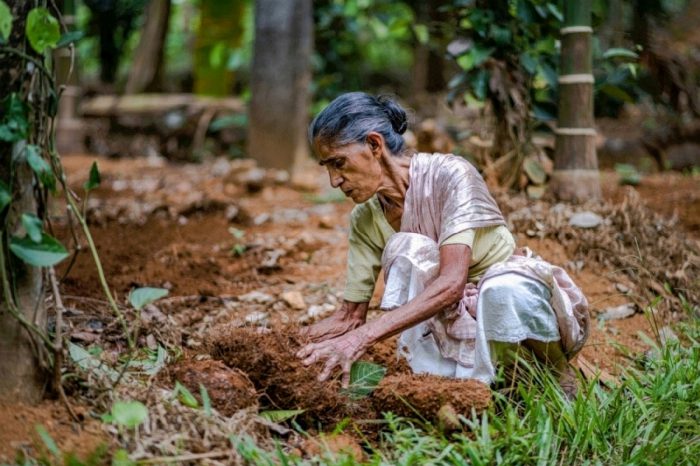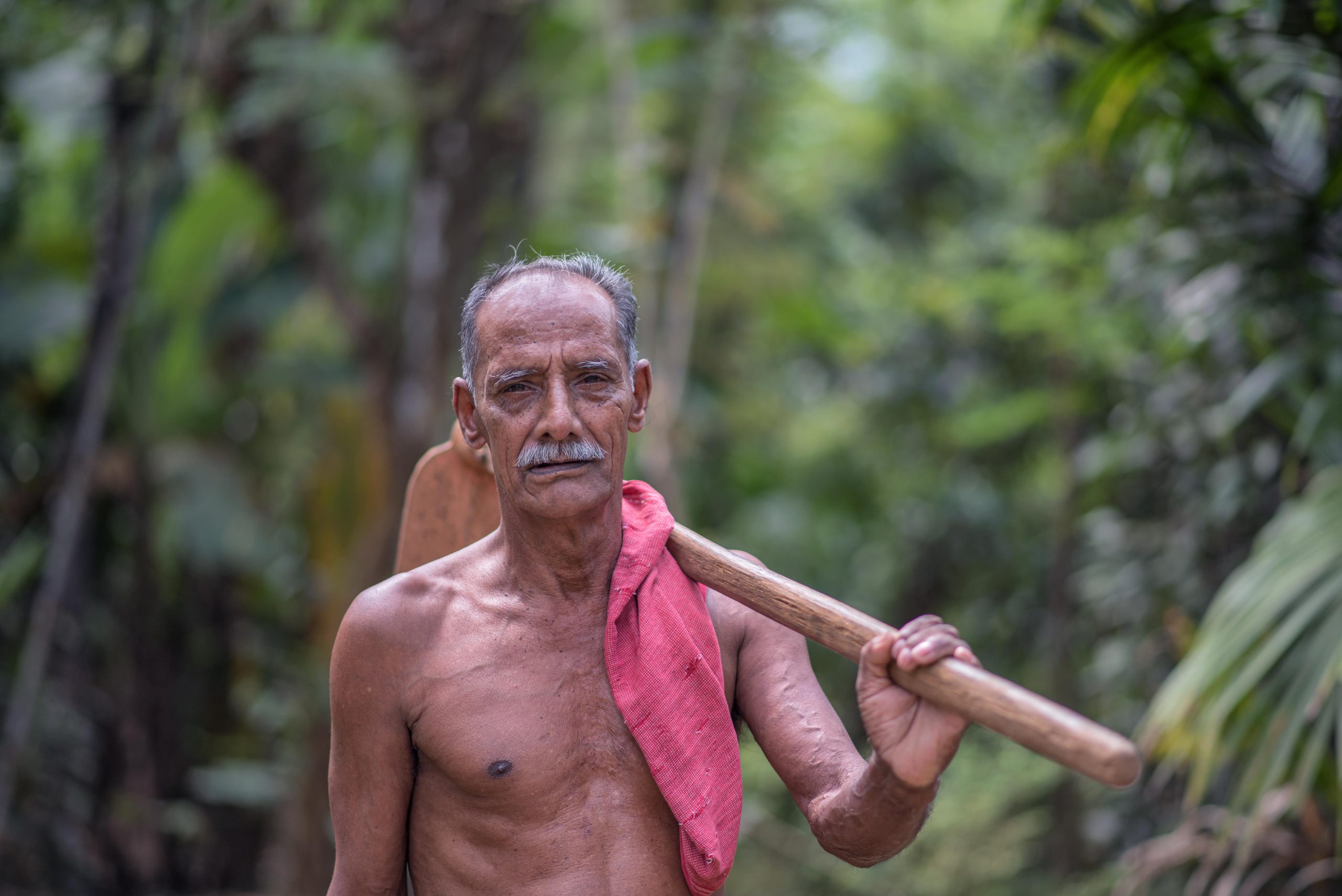MovingCamera
Photography & Travel
/// Photo trip India, Kerala & Rajasthan
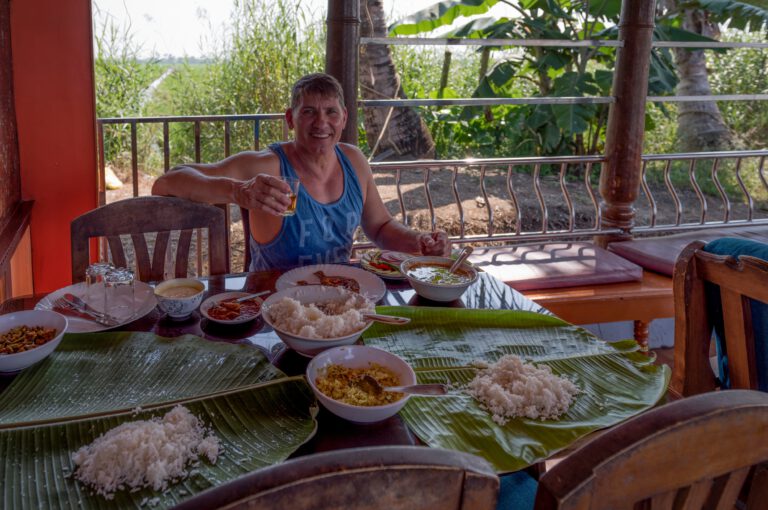
by jose christudas
Already on the way to Vellayani Lake, the largest freshwater lake in Kerala, I was very impressed by the early morning mood that I felt when leaving my accommodation on Kovalam Beach.
It was mostly locals who might be on their way to work and some international travelers who wanted to go jogging or doing yoga on the beach, amidst roaming dogs I walked to the agreed meeting point where my taxi driver was waiting for me , discovered. Especially as an early riser, it was wonderful to see who started his day in the dark and how I waited for the light of day.
Arrived at the lake, the tiredness had long since faded and I enjoyed a pronounced silence around me. Although not much was visible, I could already make out some fishermen who had gone out in their boats on the lake and, behind me, across from the lake, farmers who had already started working in the fields. For the fishermen and farmers, it is their daily bread to fish, sow and reap. It quickly became clear to me that the yields were limited, as I saw farmers walking past with only what they could carry under their arms. The fisherman would also be able to catch his own needs, with luck maybe a little more to sell on the market a few kilometers away.
My location was found. Setting up the tripod and preparing the camera was also done quickly. Now, after a few test shots, I waited for the light on the horizon to become ever stronger. On the fact that the rising sun began to play out its charms. Everything around me was still foggy and hazy, which brought with it a graceful and gentle mood due to the increasing brightness. Wherever I looked, however I turned, my eyes discovered so many details that made my soul more than happy and made my photographer’s heart beat faster.
Between the individual pictures, I kept thinking about how beautiful it was what I was experiencing here. Somehow I didn’t want it to stop. Here my soul recharged and I was in my element, capturing such incredible moments and being able to take them home with me as memories. It was a very special privilege that I more than appreciated.
Life at Vellayani Lake is characterized by a hard circumstance and the people here live very modestly with only the most necessary things. It is all the more astonishing that the people meet you in an unbiased manner and are always so friendly.
Difficult, this constant bending down, a constant up and down, plus the fact that these sacks full of grass only clearly show their weight when they are lifted. The woman watching in the picture caught my eye from afar when only her back was visible. Her strength was clearly muscular and with the morning temperatures of around 28 degrees and the noticeably high humidity, I felt like shifting down a few gears. I only had to carry my photo equipment.
Once again, I felt great respect and admiration when I saw what was happening and the fervor with which they tirelessly went about their work.
India has always been my favorite travel destination for over 30 years. All my impressions are unforgotten, just like these, thank God, they refresh again and again and help you not to forget how good you are.
Still completely blown away by my photographic tour at Yellayani Lake, my taxi driver and I quietly enjoyed the return trip to Kovalam Baeach, where I was staying.
On the way back from the lake I saw a man sitting on a motor scooter and next to him the boy with his school bag standing on the side of the road. And as is so often the case, when eyes meet, you wave at each other as you drive past. It was the beaming faces of the two that moved me to ask my taxi driver to stop. In short, I walked up to both of them and introduced myself. A lively exchange was already underway and the friendly man said that he just wanted to take his son to school on a scooter. So there was still a short moment to be allowed to take a picture of them after the question. Which was greeted with a smile and pride. Finally, I gave the boy a small souvenir, my pen. Everyone was very happy.

Delhi. I had planned to do a 12-day tour through fascinating Rajasthan, with a focus on street and portrait photography. Then we went south to Kerala for 10 days.
In advance I had organized a driver for the entire tour, as well as all accommodation. The tour guides on site were all booked to give me background information and history about the sights I wanted to visit.
Right after my hotel check-in, I grabbed my camera and headed out into the action to go somewhere to eat first. Among other things, we passed this inconspicuous and completely self-evident barber shop, which can be found everywhere in India. Those who perhaps cannot afford their own shop set up their utensils on the side of the road and serve their customers. For around 150/250 rupees, around 2-3€, you can get a shave, a haircut or both.
Although I know such pictures enough from my travels, I am always gripped by the sight of such street scenes. Once again it becomes clear how things are with the individual. With the simplest of means and the necessary craftsmanship, you can do your job where it suits you best. In the end, what counts is what you bring home in the evening to earn a living for yourself and your family.
Stopping and watching the barber at his work signaled my great interest and I quickly struck up a conversation with you. He has been practicing his craft in the same place for many years, and in addition to the casual customers he even has a loyal, returning clientele. If it starts to rain, a quickly installed tarpaulin offers quick protection. My question about being allowed to take a picture of you at the end was kindly answered in the affirmative.
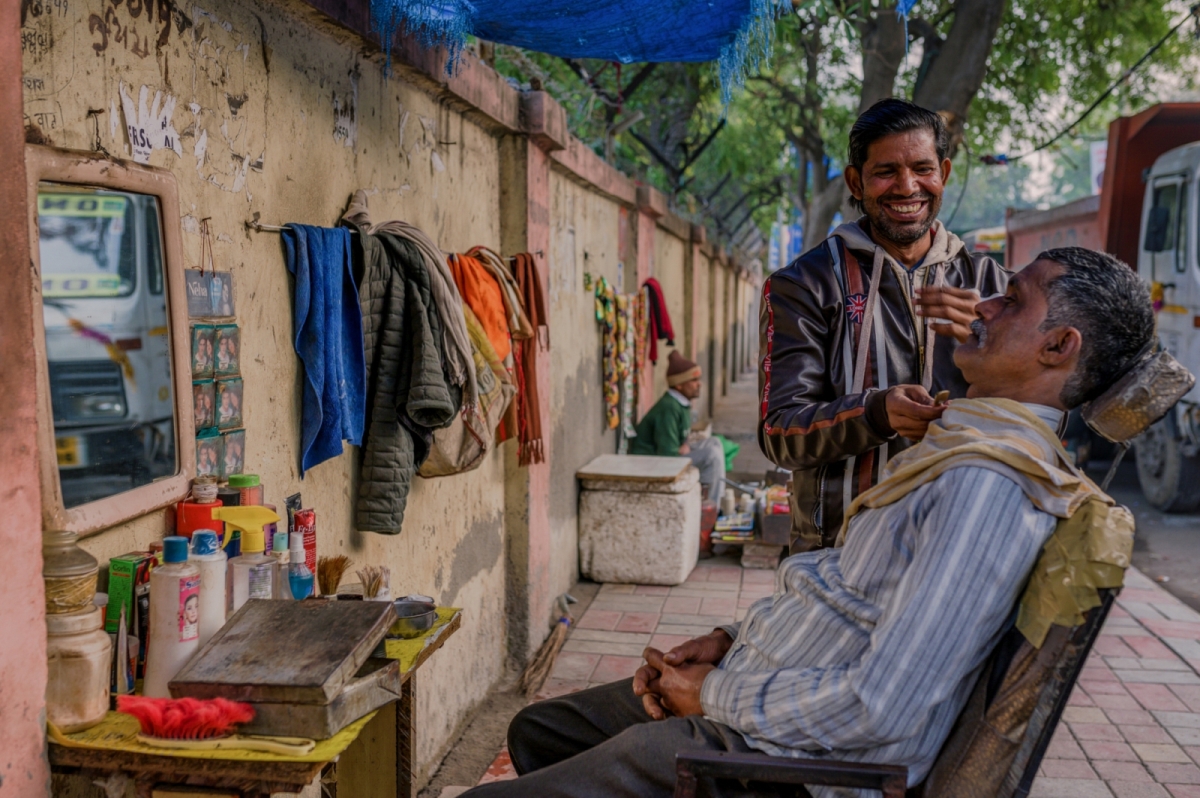
Street food and drinks are prepared here right in front of our eyes. The finger food, which is often unfamiliar to us, may not be familiar with either the taste or the spices. Reluctance would be understandable here. With the drinks you can at least see which fruit it was pressed from. However, it is advisable here in particular to have these prepared without ice cubes, because the origin of the water used cannot usually be traced. Street food not only in India means that everything edible is offered cooked, fried, grilled or roasted at the countless street stalls and food stalls.
Those who have found their taste buds will certainly want to try most of them. The quick preparation and the high demand speak for themselves. I’m just saying, just queue up and let yourself be surprised. I usually try everything I see to eat and drink myself and I’m always surprised at the culinary delights I experience.
Everyday life is difficult, especially if you don’t have a regular job that you can do and that gives you at least a reasonably secure income.
This morning encounter with these men speaks volumes. In fairly cool temperatures of around 7°C, they crouch around their sparsely made fireplaces, waiting to be approached to get work for at least a few hours or, if you’re lucky, for the whole day.
Talking to them and finding out what their everyday life is like really moved me. I was rather embarrassed by the special expression of cordiality they showed me. They immediately invited me to warm myself by their fire as well.
Crouching down to do the same sparked mutual glee. The ice broke so quickly. Accordingly, my gesture of handing them some rupees was correctly understood. In the end, this expressive picture was created.
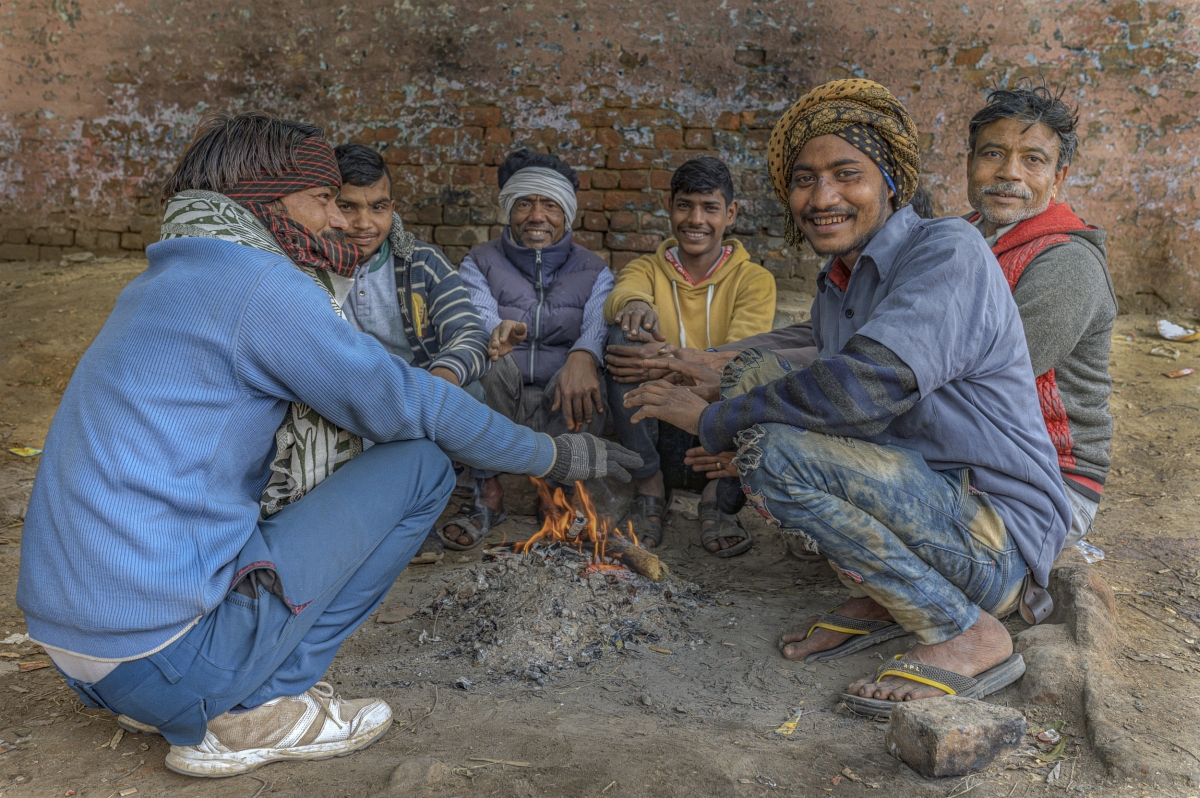
The Taj Mahal is probably one of the most photographed buildings in the world, the Indian tomb, also known as the 8th wonder of the world, rises on the south bank of the Yamuna River on the outskirts of Agra in the Indian state of Uttar Pradesh. The Muslim Mughal Emperor Shah Jahan had the building built to commemorate his great love Mumtaz Mahal, who died in 1631 (an excerpt from Wikipedia, many thanks).
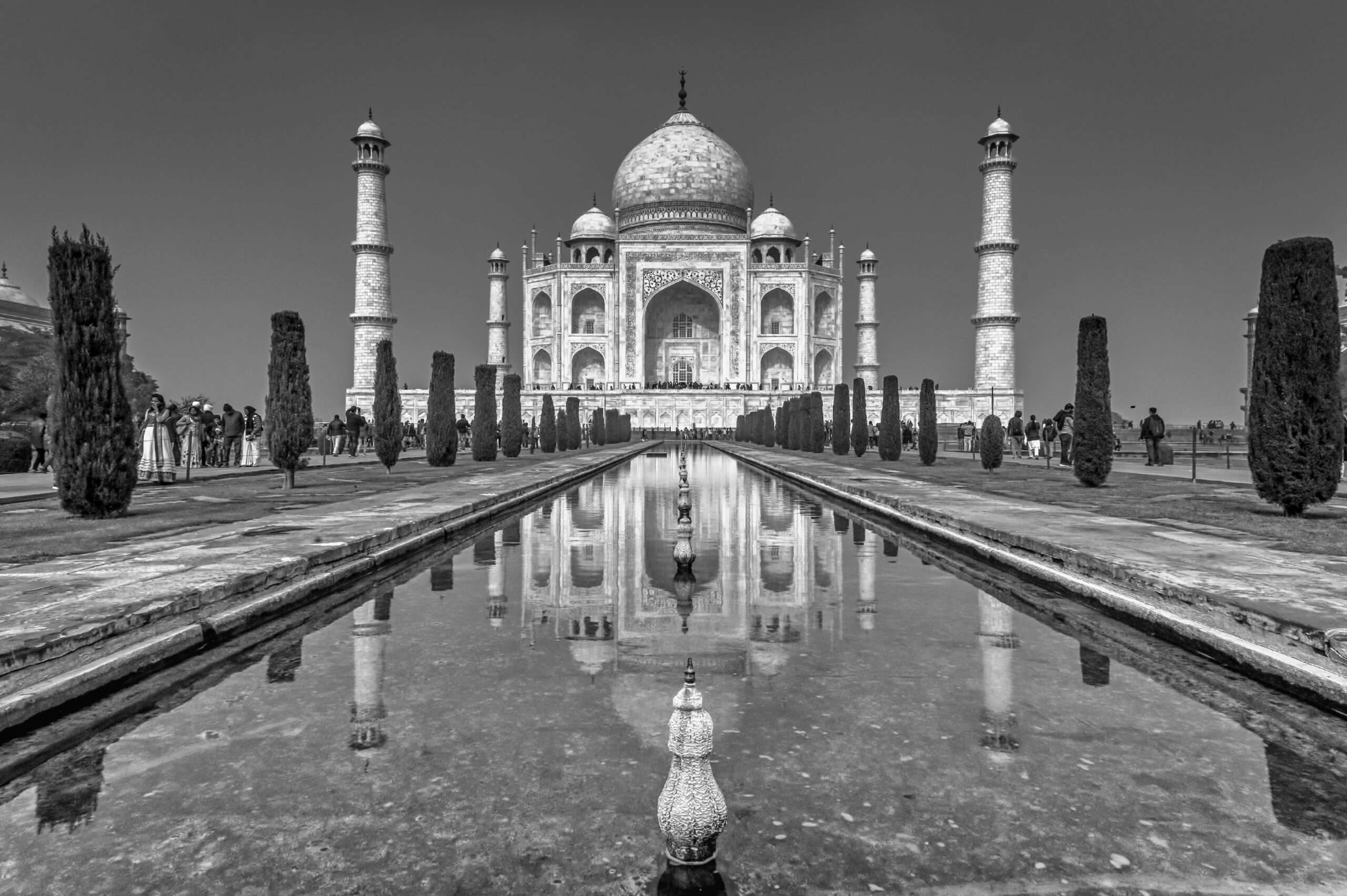
Music is played everywhere in India, with and on different instruments, here you can see the traditional drum and the Indian harmonium, which covers a good three octaves and is smaller than the European version. A bellows is attached to the back wall, which is constantly operated with the left hand, while the right plays the melody lines, occasionally also chords. It is mainly used in folk and devotional music
Indian music in all its diversity has fascinated me since my first trip there, in 1989. Here, too, being with the musicians and giving my senses to their music was again a pleasure.
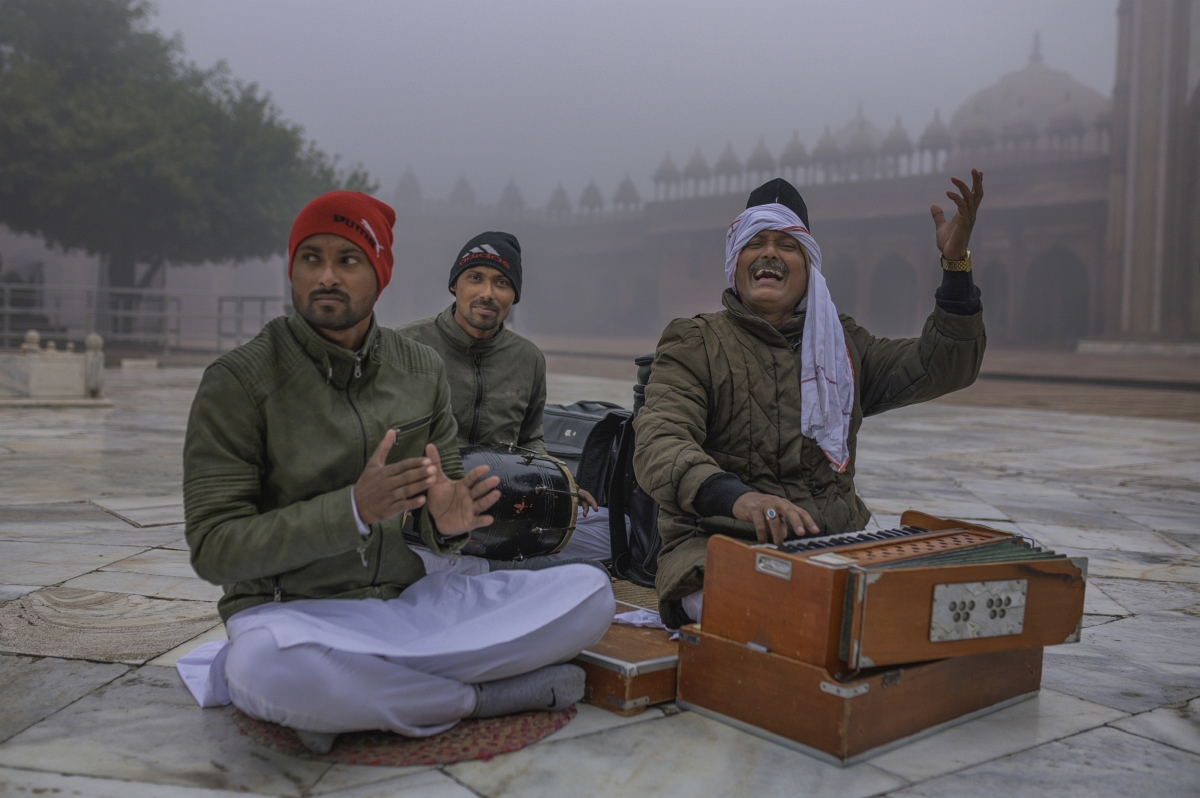
On the way to the Fatehpur Sikri Fort in Agra, I met the stonemasons who have to earn their daily living working the red sandstone under really difficult conditions.
It is not just the weather conditions, but above all this extremely difficult posture that this activity demands. An eight to ten hour day for six days a week is everyday life for the men. I don’t want to mention the merit here, it’s just degrading.
For me, this picture reflects the hard and humble life there on site, to which so many people around the world are exposed. There is almost no government support that could help here. It is poignant and embarrassing at the same time to witness such circumstances. It’s always striking that you don’t hear anyone complaining here.
The palace „Jal Mahal“ (Water Palace) and the Man Sagar Lake were built in the 18th century by Maharaja Jai Singh II. For me it was a highlight that had to be visited. So I was on the road in Jaipur very early in the morning that day to experience the sunrise directly at Lake Man Sagar. What a morning mood I experienced on the shore. Standing there in the dark and waiting for the light that gradually opened up on the horizon. It was also wonderful to watch the birds, which kept flocking in swarms all over the lake and all of a sudden settled down somewhere. And because it was such an impressive atmosphere, I came here again the very next day. Pure enjoyment.
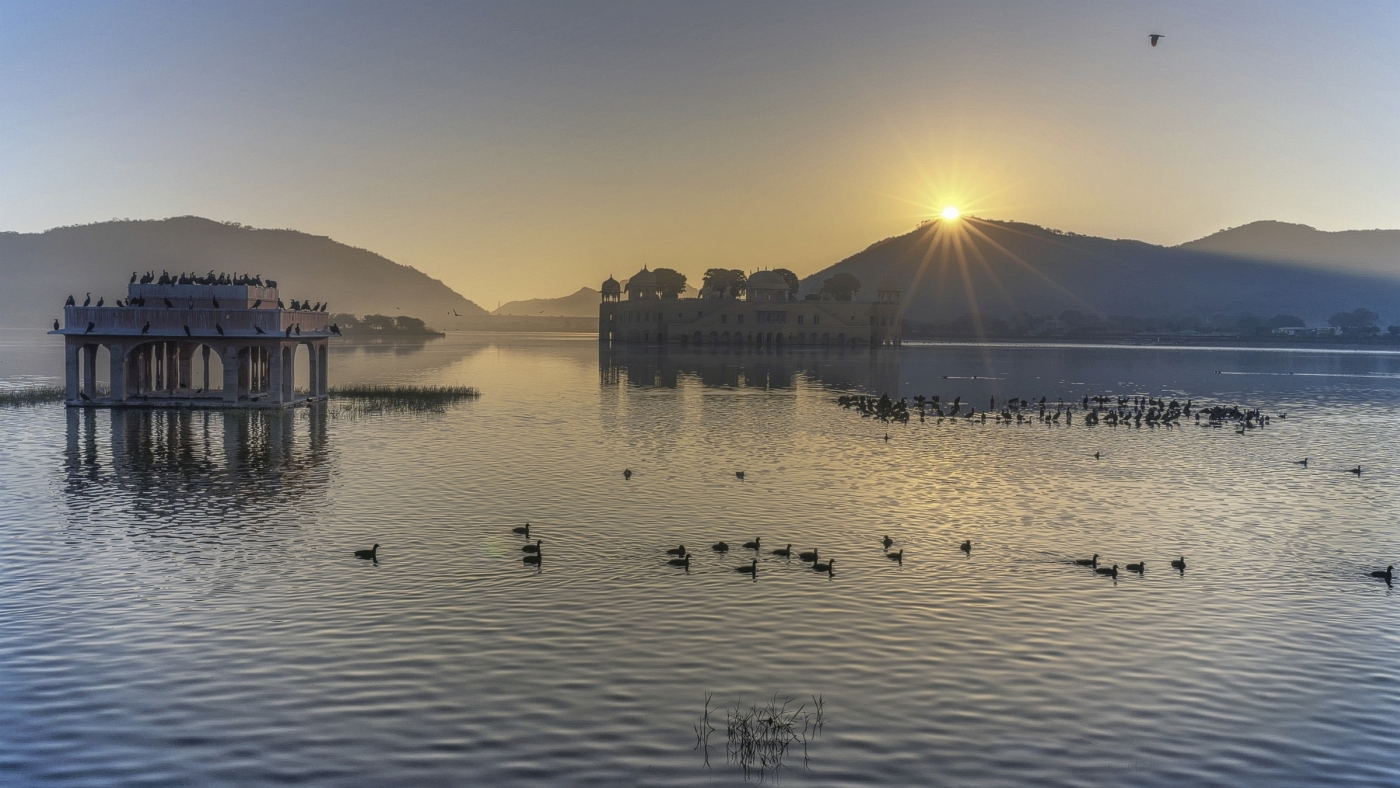

This woman with her glowing headgear caught my eye from afar. She stood with two other women in a small garden in Jaipur to tend lawns and flower beds. It was lunchtime and they were sitting and standing on the lawn in the blazing sun, eating the food they had brought with them and chatting when I joined them.
I greeted them as they passed and was immediately impressed by their kindness in giving me a smile. I immediately stopped and asked how they were doing in plain English. They didn’t speak a syllable of English and I didn’t speak Hindi. So I asked a passer-by, who I hoped spoke English, if he could translate for me. I was lucky and was able to ask her about her job right away and let her mention how well maintained everything looked. I was asked where I came from and whether this was my first time in India and how I like it here. This quickly became a fun exchange.
Finally, I asked if I could take some pictures of you. Their friendly smiles and the slight sideways bobbing of their heads signaled their approval. A European who shakes his head indicates a clear no. In India, bobbing one’s head sideways means a benevolent assent. The longer the head is moved back and forth during the conversation, the greater the attention.
Thank you for this beautiful and spontaneous encounter, which I remember fondly.
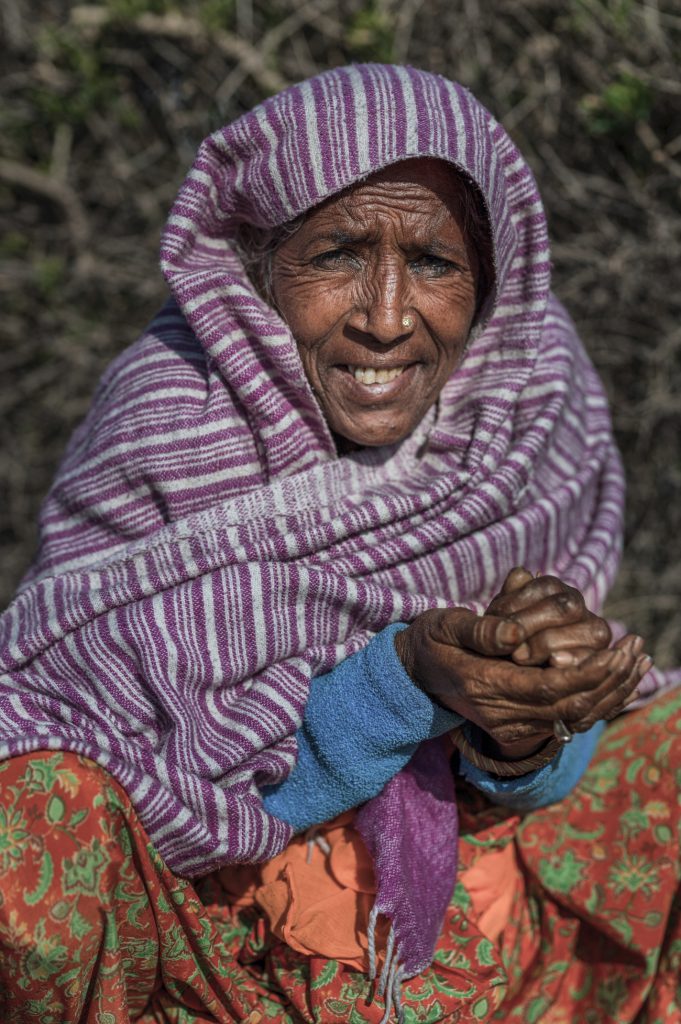
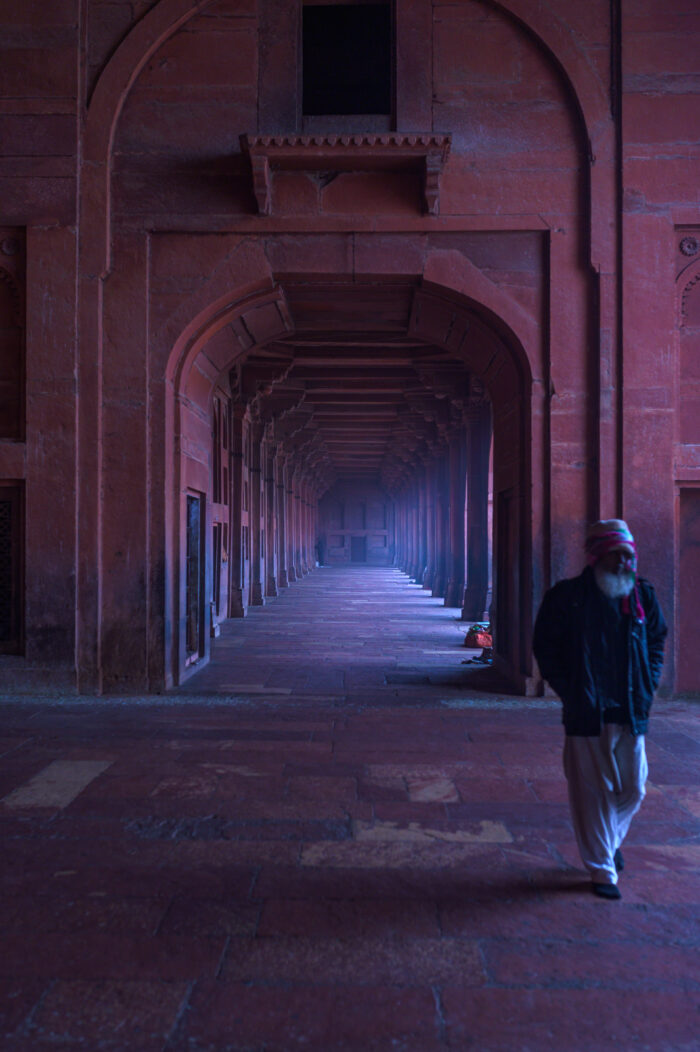
A beautiful scene that I discovered for myself. A certain touch of Lost Place gave off this already quite battered facade, in front of the wonderfully old bicycle. Add to that the white plastered window arches, two strong protruding columns and the dominant, dark brown closed door with its chrome-plated lock in front. The hanging cut cable is another fitting detail. Light and some shadow included.
Outside the picture was this man. We immediately struck up a conversation when he saw that I wanted to take a picture. He wanted to get out of the picture completely when I asked him if he’d rather be in the picture. It’s best to sit down, talk on the phone and pretend I’m not even there.
Said and done. This moment was captured in no time without making it seem staged. What fun we both had, unbelievable, without ever having met before.
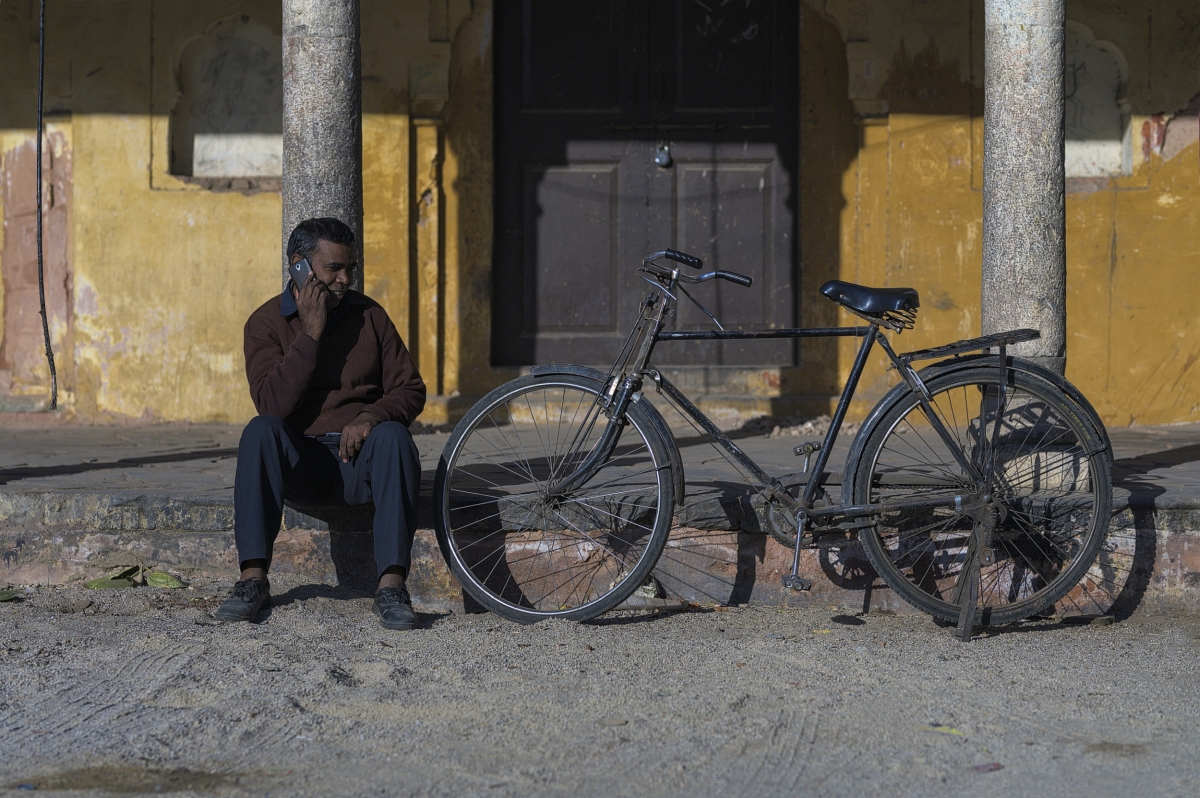
I had an interesting encounter when I was strolling through the narrow and winding streets of Jaipur and saw this man sitting under a shady canopy as I passed by.
Quite simply, without words, because neither of us spoke a foreign language, my gesture asking if I could take a picture of him was positively received.
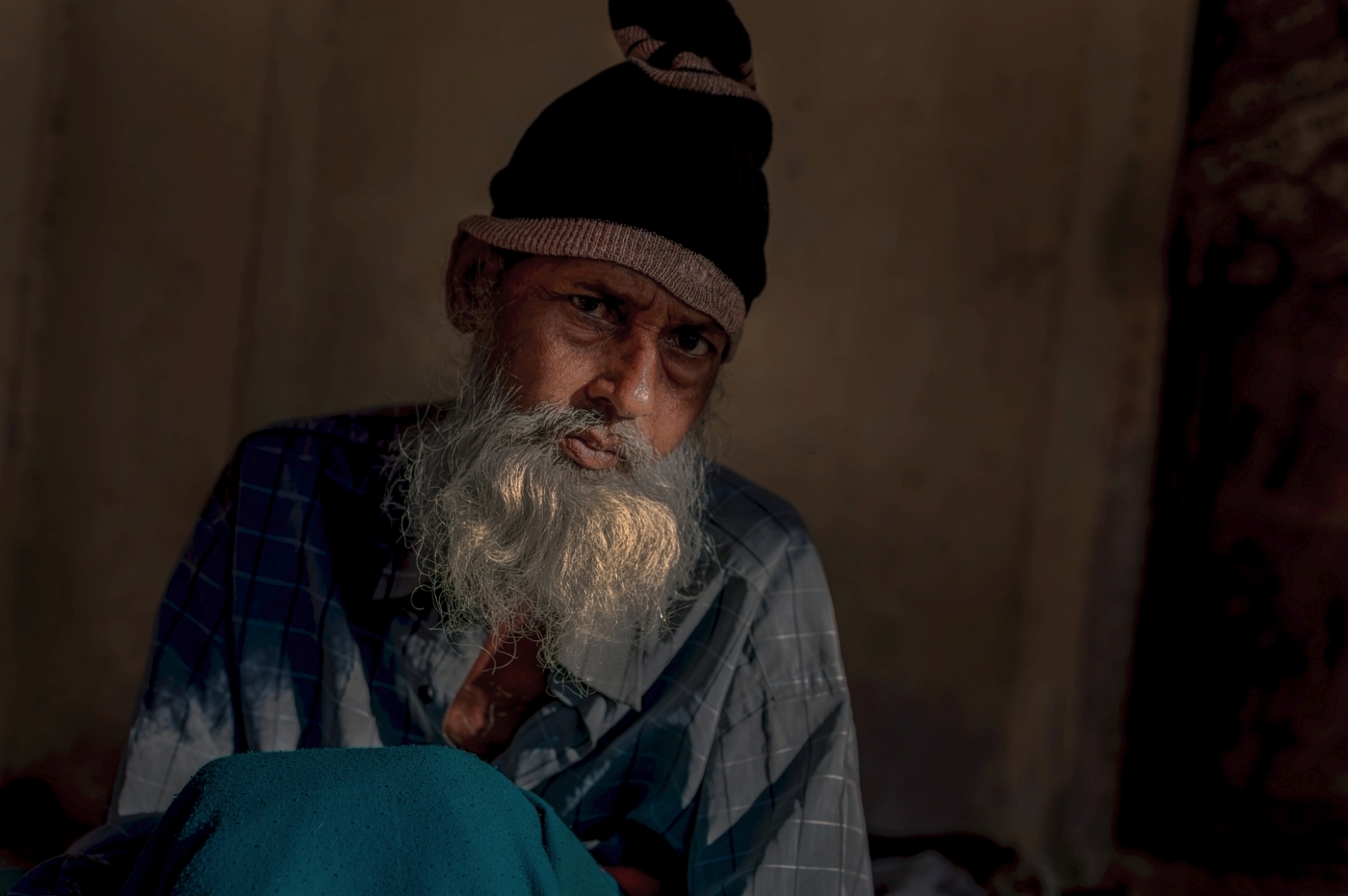
Rajasthan stands for vibrant culture and royal history. Visiting this beautiful and graceful state gave me incredible on this great journey to also gain a lot of cultural impressions like here also visit the royal monument Maharani ki Chhatri in Jaipur, Amber, which once again expresses ancient India brings.
Chhatri, also called Queen’s Umbrella like the Maharani ki Chhatri, is a unique memorial to the Mahararanis or the royal wives and basically serves as a source of shade.
Temple complexes must also be seen from the inside. An unbelievable masterpiece of craftsmanship, which also comes to light here at the Jagat Shiromani Temple, is immensely impressive and literally takes you on a long journey through time. I am always impressed to visit such cultural sites. You are expected to remove your footwear.
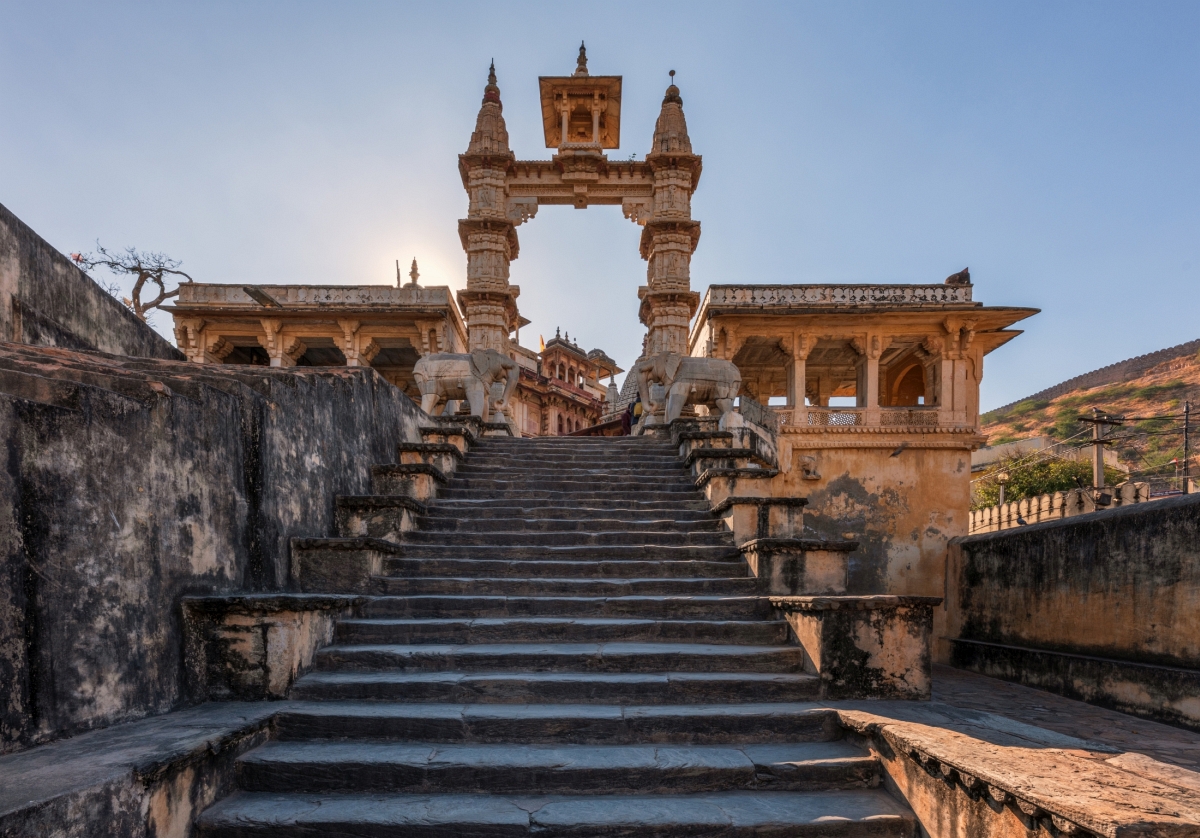

Those who travel to Rajasthan, the north Indian state bordering Pakistan, will likely, as I have, visit Jodhpur, the second largest city in the state after Jaipur.
Its palaces and fortresses are reminiscent of the many kingdoms that once fought for supremacy in the region. Jodhpur is also called the „Blue City“ as most of the buildings in the city are painted blue. This special coat of paint was traditionally reserved for Brahmins (priests). But over time, the painting of the houses was taken over by all residents. Today this color is the trademark of the city.
This picture was taken while visiting the impressive Mehrangarh Fortress. It is located at a height of 123 meters on a single rock and towers over the whole city of Jodhpur. However, before you visit the medieval fortress, you should take some time to admire the beautiful view of the blue city.

For me, a visit to the Hawa Mahal „Palace of Winds“ was a must. I’ve heard so much about it and also seen pictures that I didn’t want to miss the architecturally impressive and extraordinary building in the old town of Jaipur, Rajasthan, with my own eyes, and of course through the viewfinder of my camera. The imposing building front of the huge city palace alone conveys the expensive lifestyle of the Rajput princes. The palace was built by Maharaja Sawai Pratap Singh in 1799 and is certainly one of the most visited sights in India after the Taj Mahal.
Standing in front of it gives me goosebumps. I inhale what I see and can’t get enough of this architecture. I have to let that sink in first. I enjoy the physical sight and use the variety of my focal lengths to reflect different impressions of the building. Literally. So, after shooting with 14mm, I was still looking for a location that would give me a more unusual perspective.
Opposite the palace, on the other side of the street, there were many houses high enough to offer me exactly this opportunity. It didn’t take long either, a local noticed me with my camera and that I was probably looking for a higher location. He pointed to the sky and explained that he owned a small cafe there, which, however, due to the early morning, was not open yet. From up there I would have a wonderful view, he explained, to take beautiful pictures. It was clear to me that I should also give him something in his hand. Of course I did. So I took a few pictures from this height. When I looked around, I saw how the palace front was reflected in the window glass of the cafe.
Thanks to the friendly owner of this cafe for his courteous foresight.
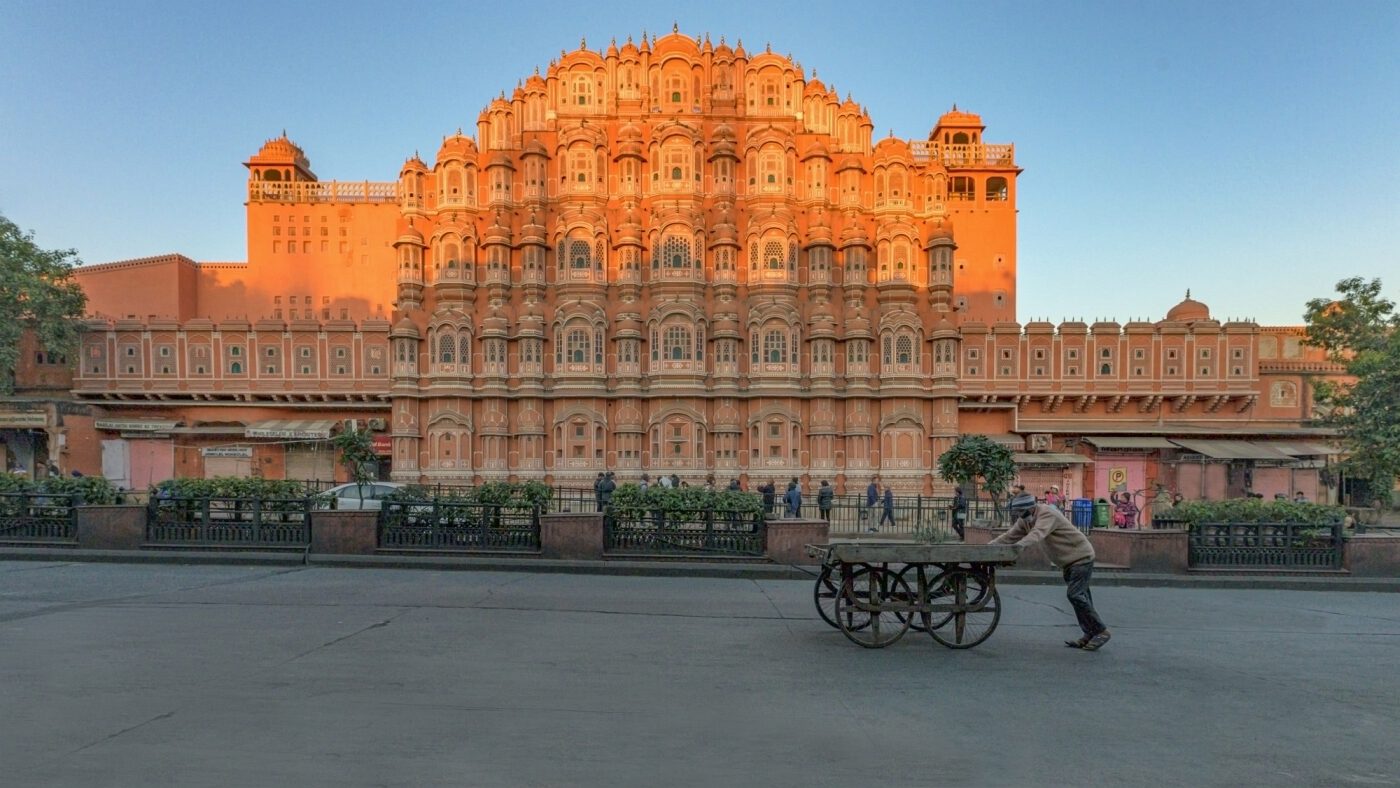
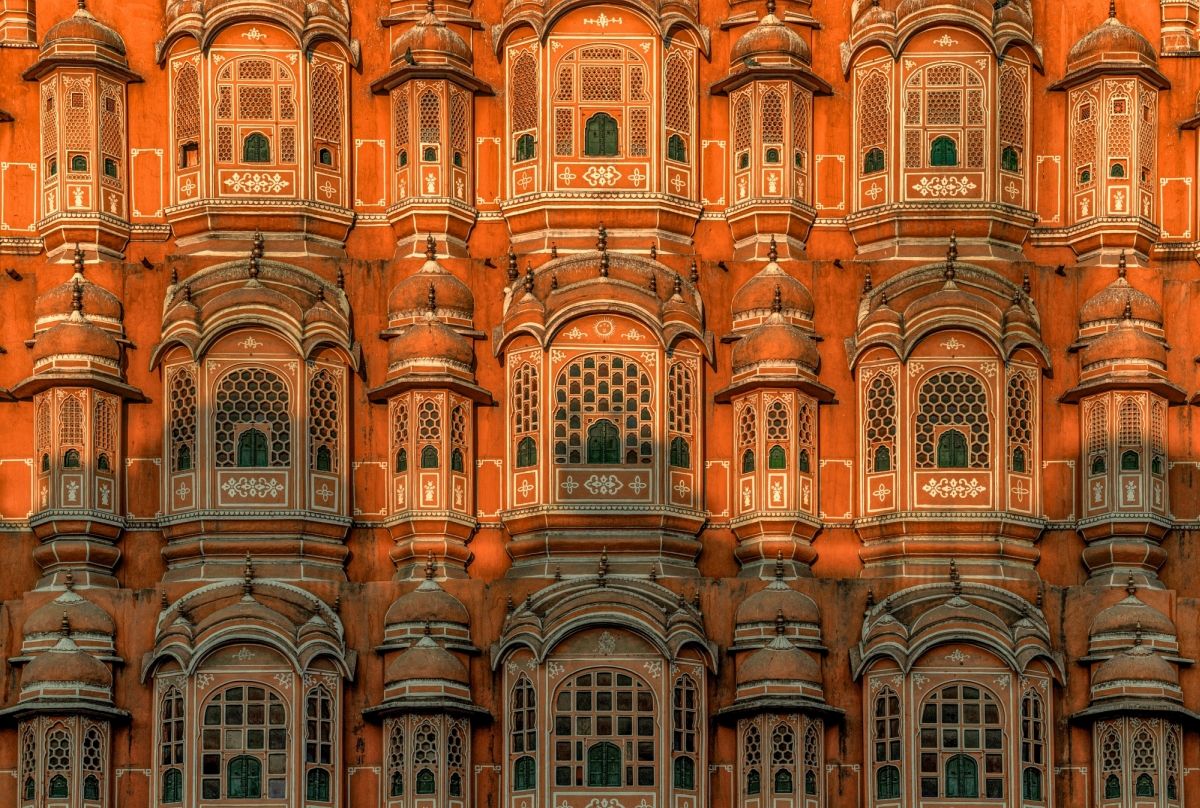
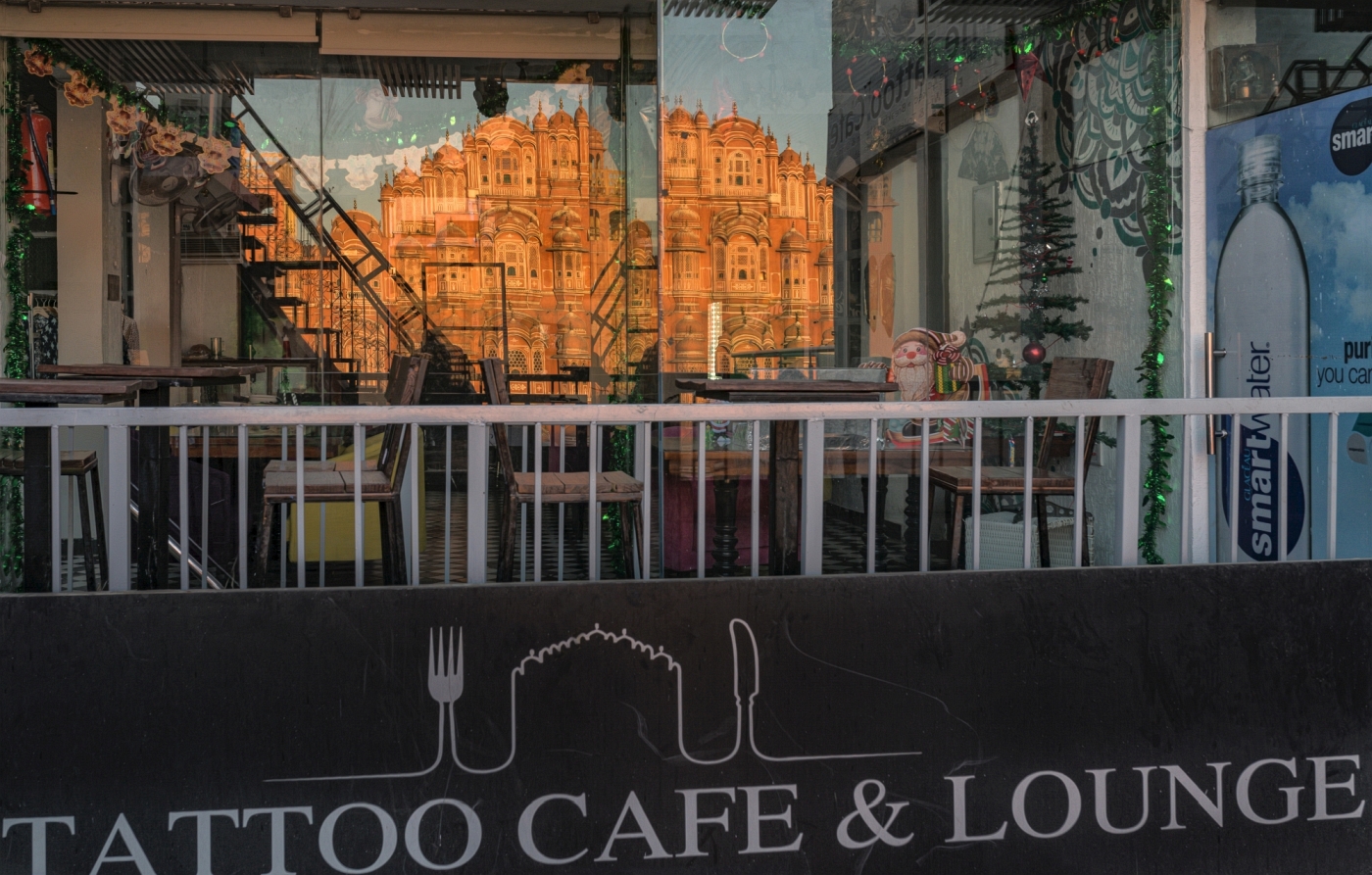
As already mentioned, this year’s trip to India took me to Rajasthan for the first time. I had organized the round trip with my own driver and started in Delhi, via Agra, Jaipur, Jodhpu, Jasialmer, Udaipur, back via Jaipur to Delhi and then by plane to Kerala, Trivandrum. For the intended destinations, tour guides were available on site to give me everything interesting about the sights.
On the one hand, I was able to get involved in the cultural and historical diversity of the north Indian state, but on the other hand I could also consciously devote myself to my passion, street and portrait photography.
There were situations, like here along the way to the Taj Mahal, that I could hardly get past without stopping to talk to people. Quite spontaneously from the gut.
Taking photos is one thing for me, but the attraction for me is also coming into contact with people. Sharing what moves people, how they live and what they have to tell enables me to learn more about the people of India and the country itself.
So my journey remained incredibly varied, lively and exciting at the same time.
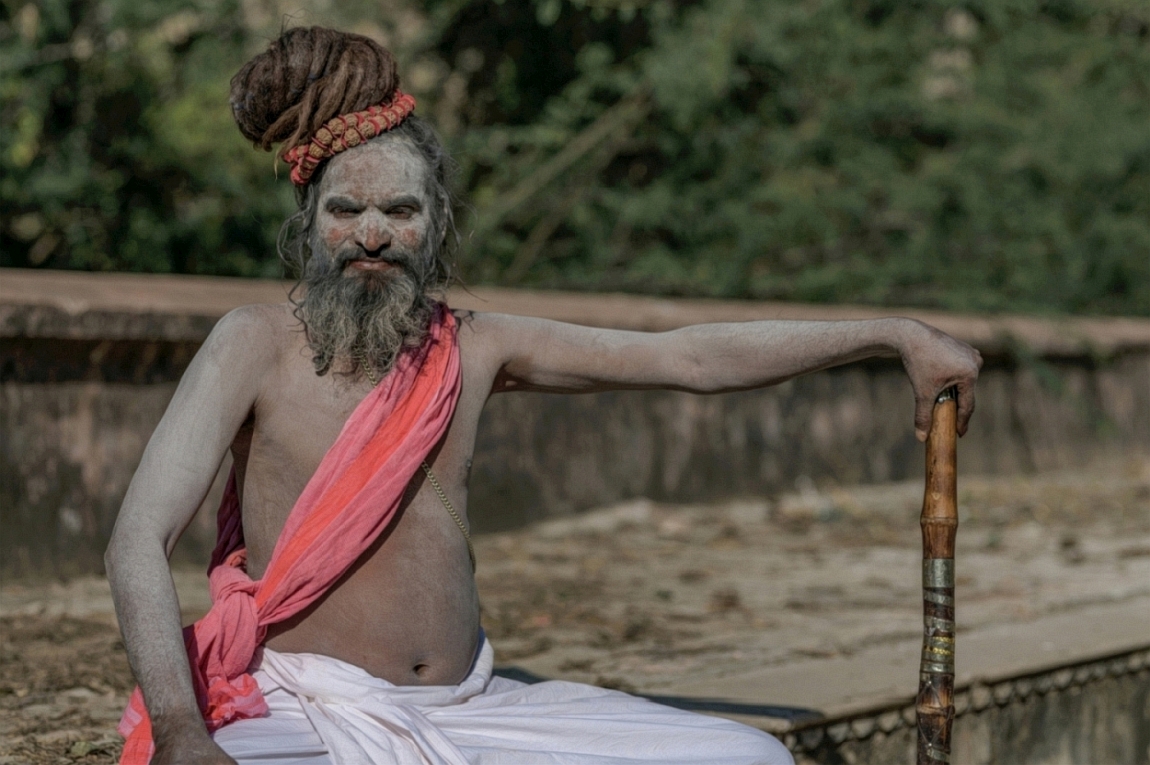
The followers of the god Shiva have always fascinated me. The sadhus. Cut off from all worldly matters, the wandering monks live in poverty, renouncing missions and eating what they find along the way. Their goal: divine salvation and under no circumstances rebirth as it arises from the belief in Hinduism, according to which the body dies, but not the soul. The sadhus arose from a tradition that is more than three thousand years old. They renounced everything that social life entails. Wealth, prestige and material goods were never desirable for them.
I had my encounter with this Sadhu in Jodhpur. Along the way I discovered him and I couldn’t help but talk to him and exchange ideas. His charisma magically attracted me and I also admired his magnificent hair, which he has been growing for over 40 years. For years he has been moving from place to place across the country, but has also spent many years in seclusion just meditating. Contentment seemed to rest within him.
For me it was once again a very interesting and, above all, unusual encounter. I, who is so firmly anchored in social life.
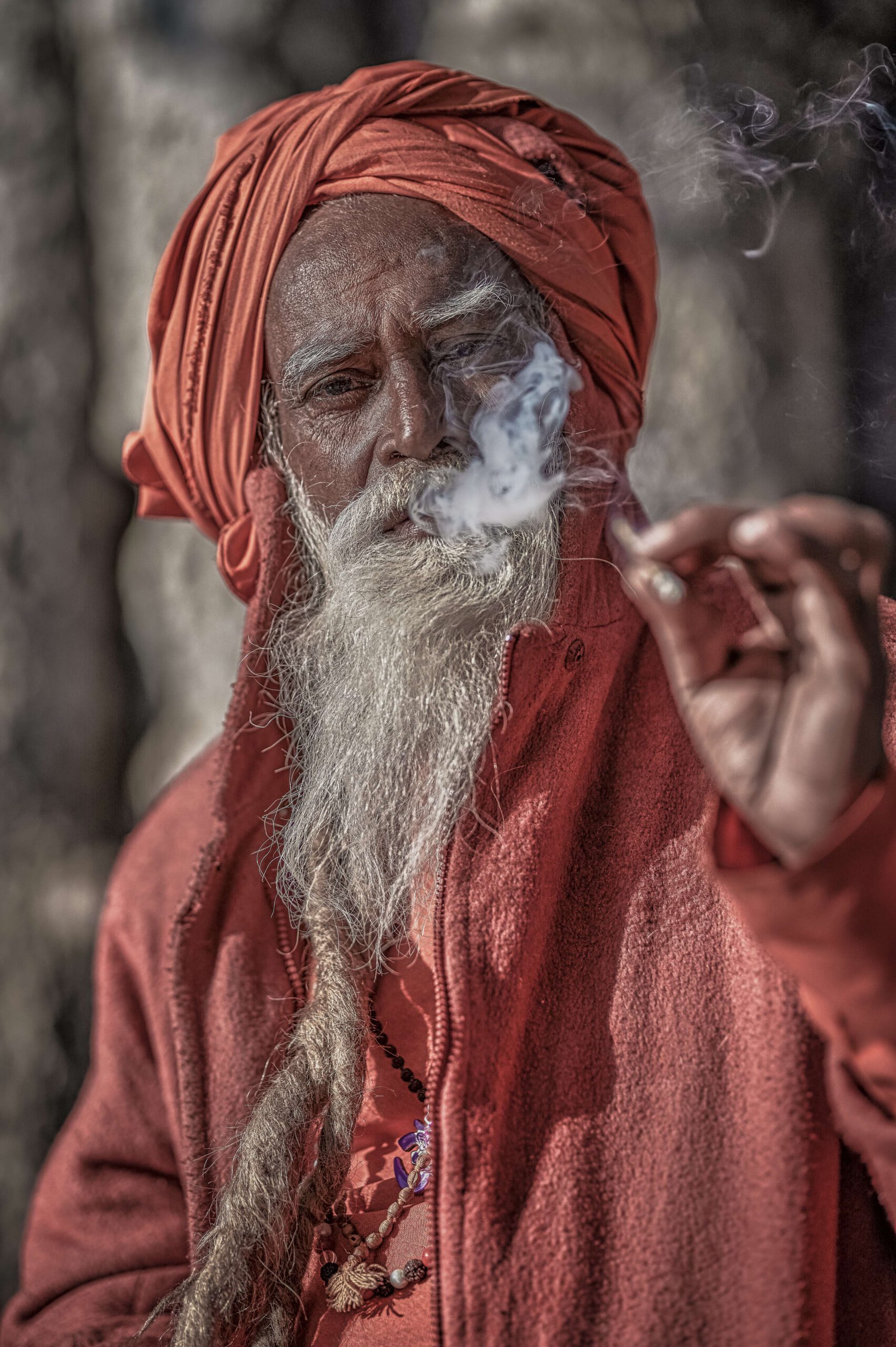
Along the way, around the sights, everything imaginable is for sale, like here a beautiful musical instrument woven from raffia.
I would have liked to take some things with me as souvenirs or as small gifts for family and friends. However, since I still had domestic flights ahead of me, my possible permitted luggage weight was reduced by a whole 7 kg. Due to the fact that not only the entire photo equipment weighed quite a lot, I still had thick winter clothes and summer clothes for the south in my luggage .
Even if you didn’t buy anything in the end, the people were always friendly and showed understanding.
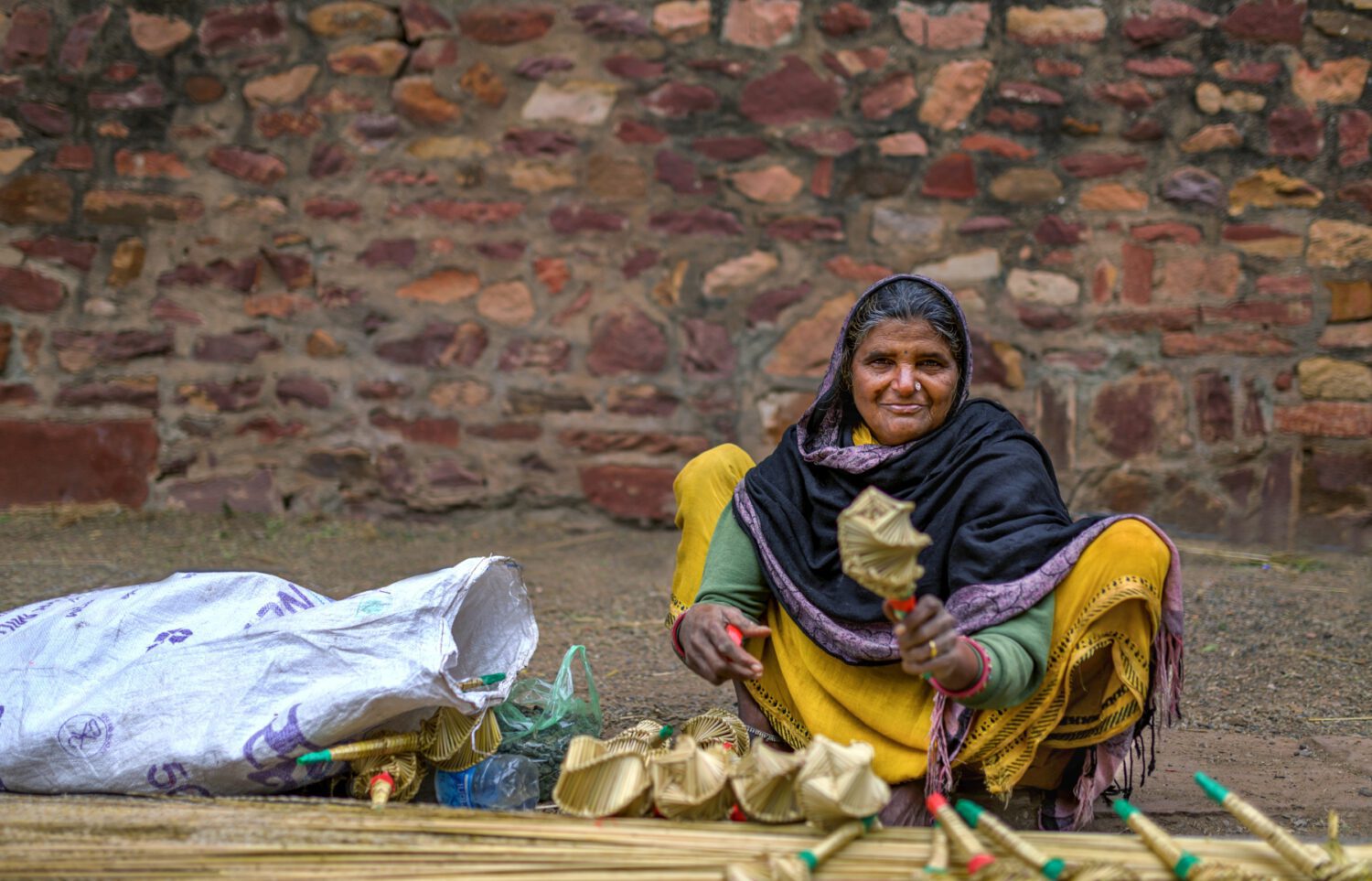
From Jodpur to Udaipur it is a good 270km to drive. Since I had organized a car and driver for my entire Rajasthan trip in advance, I was able to stop on the way or change the route a little as needed. The accommodations were also already booked, so I was not tied to having to show up somewhere on time.
Normally you would plan about 6 hours drive for this route. As a rule, I still had quite a bit of time to stretch my legs, like here, we stopped to fill up. I discovered this small repair workshop, approached it and immediately struck up a conversation with the people. That’s how I found out that the men here repaired motors, electrical appliances and small machines. There was nothing they hadn’t fixed, one of the men said. You should bring it over and then you will see what can be done. Meanwhile, my driver came up to me and signaled that we could continue. In short, when saying goodbye, I asked for a photo, which was immediately answered in the affirmative.
I went to the car and got my camera, which was always handy in the back seat for moments like this. I just say thank you for this reminder.
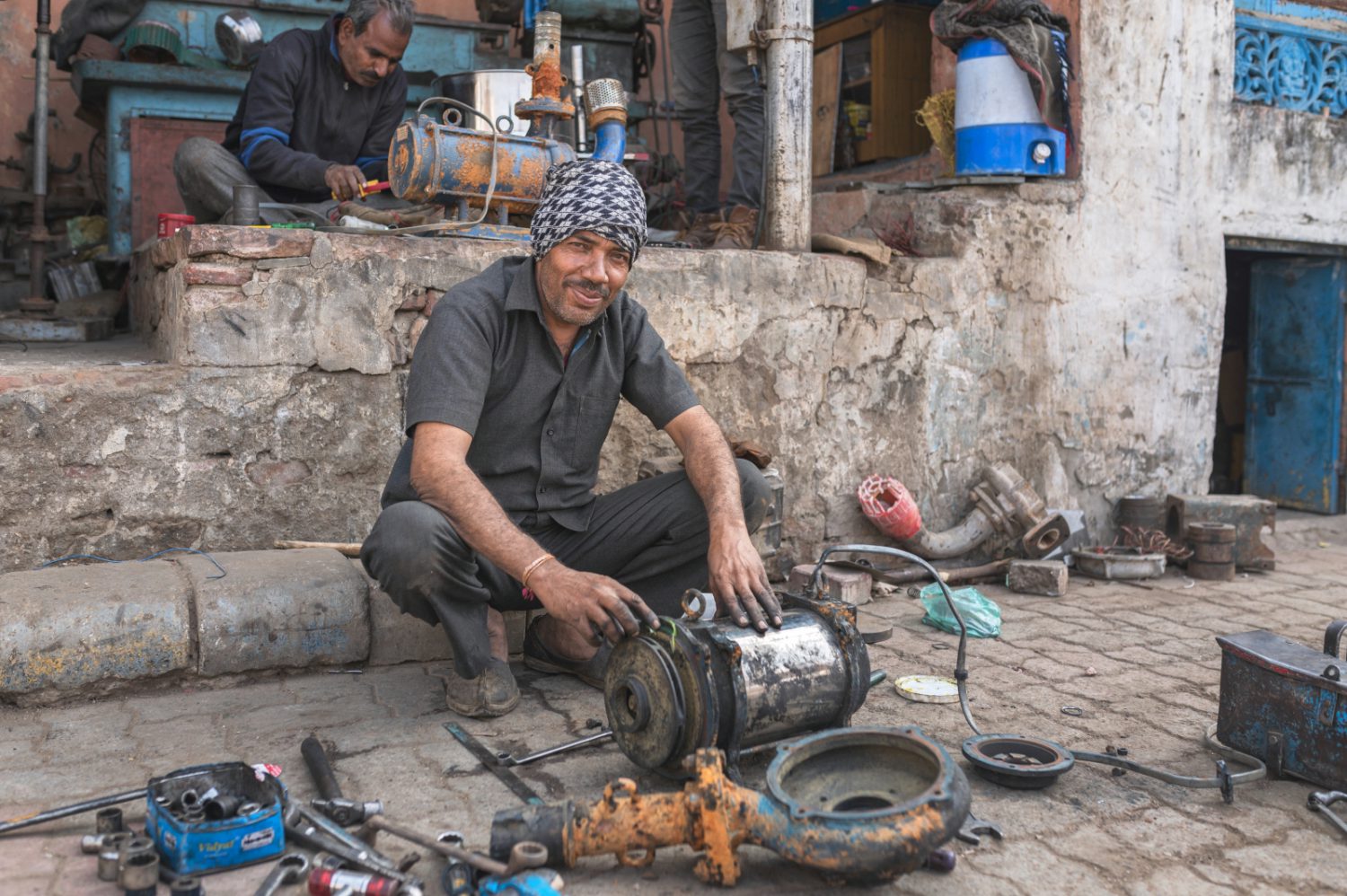
Right after breakfast, we left Jodpur for 310KM to the desert city of Jaisalmer, which lies in the heart of the Thar Desert… a city full of color and rich tradition. Once an important center on the trade route between India and the West.
We made a roadside stop to stretch our legs on our way to Jaisalmer. Far away from it all, in the midst of this barren landscape, rested this native who was resting there with his herd of camels for the day.
One searched in vain for his dwelling. Here he wanted to set up a small tent for later. A few blankets and a campfire to get through the night was basically all his belongings, along with something to eat and drink. The temperatures go down from around 25 degrees during the day to 10 degrees at night. It’s really cold and the wind is howling in the Thar desert. Simple and modest, he goes about his everyday life, just like his father, according to tradition and custom.
At this point, thank you again for the friendly welcome and interesting exchange, which my driver conveyed to me in the best possible way. Thank you also for this special souvenir photo, which reminds me of our encounter and once again illustrates how difficult and hard life is for countless people in the world.
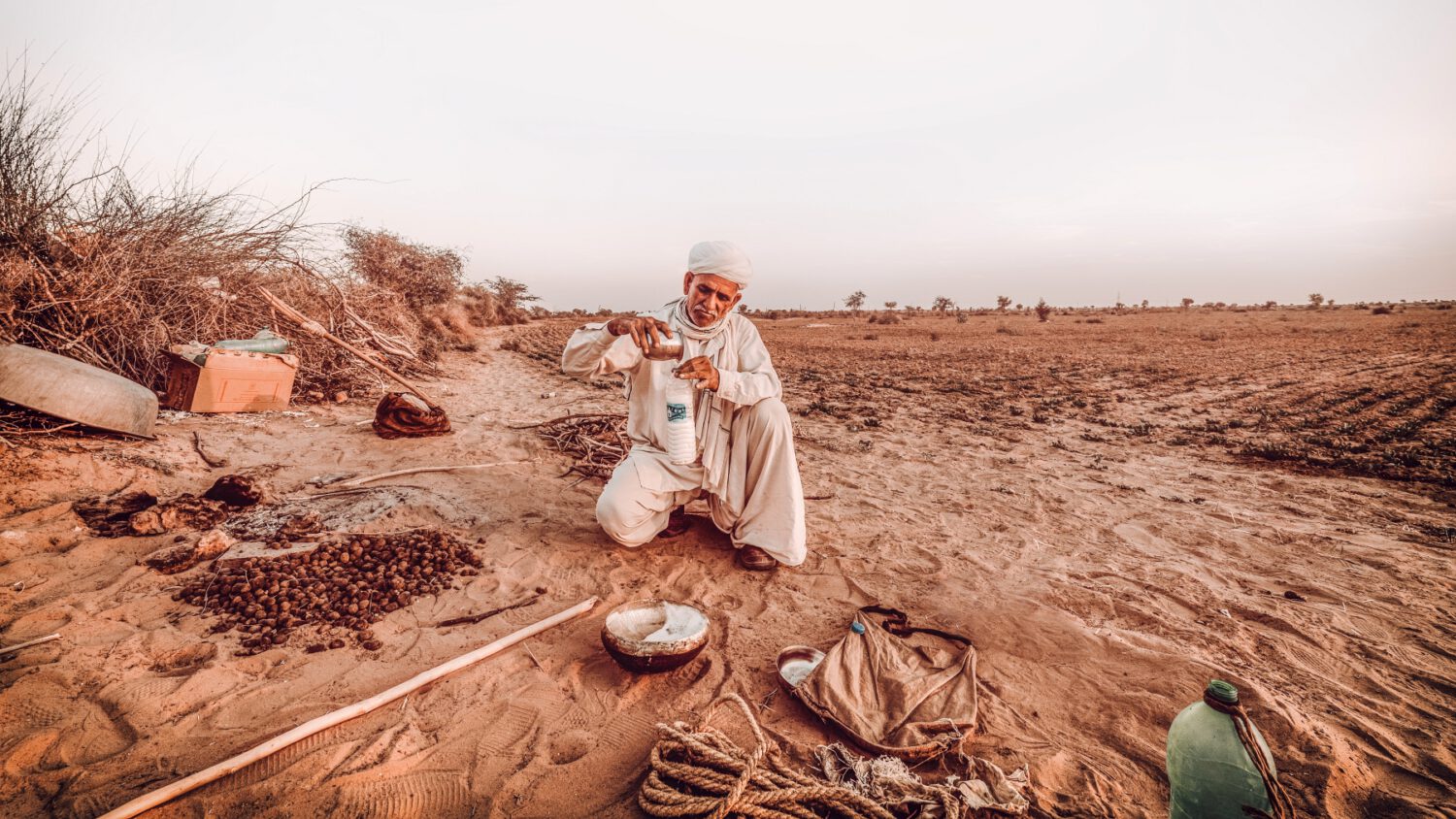
It was supposed to be more of a short stopover to stretch your legs. However, if you are as welcome as we were, then there is no reason not to pay my full attention to the traditional events.
I have always been fascinated by life in the desert. Sure, I have absolutely no idea what it means to go about my everyday life and livelihood under these circumstances and adversities.
What I can say for myself is that desert and steppe have always magically attracted me. Maybe it’s the seclusion and loneliness that appeals to me, maybe it’s also the difficult conditions as a challenge that you sometimes want to exchange for our prosperity and our comfort.
Here I discover and experience that time has somehow stood still. As I know it from home, I’m shocked to see how fast-moving our time has become. On the one hand, you only have twenty-four hours at home, like here on site. One reason I think our time at home flies by is because our days are packed to the brim with things, important and less important. If we do nothing, we almost get a bad conscience.
But here everything seems different. My soul dangles all by itself. Ever since I first arrived in Delhi, I have, as I always do, taken it easy from the first moment. A timepiece on my wrist has been alien to me for years. I only really want to be on time when I have an appointment with a tour guide, some of whom I have booked for certain sights. Then my cell phone helps or I just ask someone what the time is.
But that is no longer an issue for today. We only drive a good hour, then our destination for today, our accommodation, is reached. So there is almost enough time, at least to stay until sunset to enjoy this special atmosphere and the gesture of hospitality.
It’s quite adventurous just to get into conversation with complete strangers off the route. There is always something to tell and is definitely interesting for everyone involved. Even the fact that I have the opportunity to gain insight into the man’s life and even be allowed to take photographs, I have great respect for that. I’m thankfull.
While my driver is exuberantly chatting with the camel driver, both speak Hindi, I start to roam around a bit. I was also impressed by the camels in their surroundings.
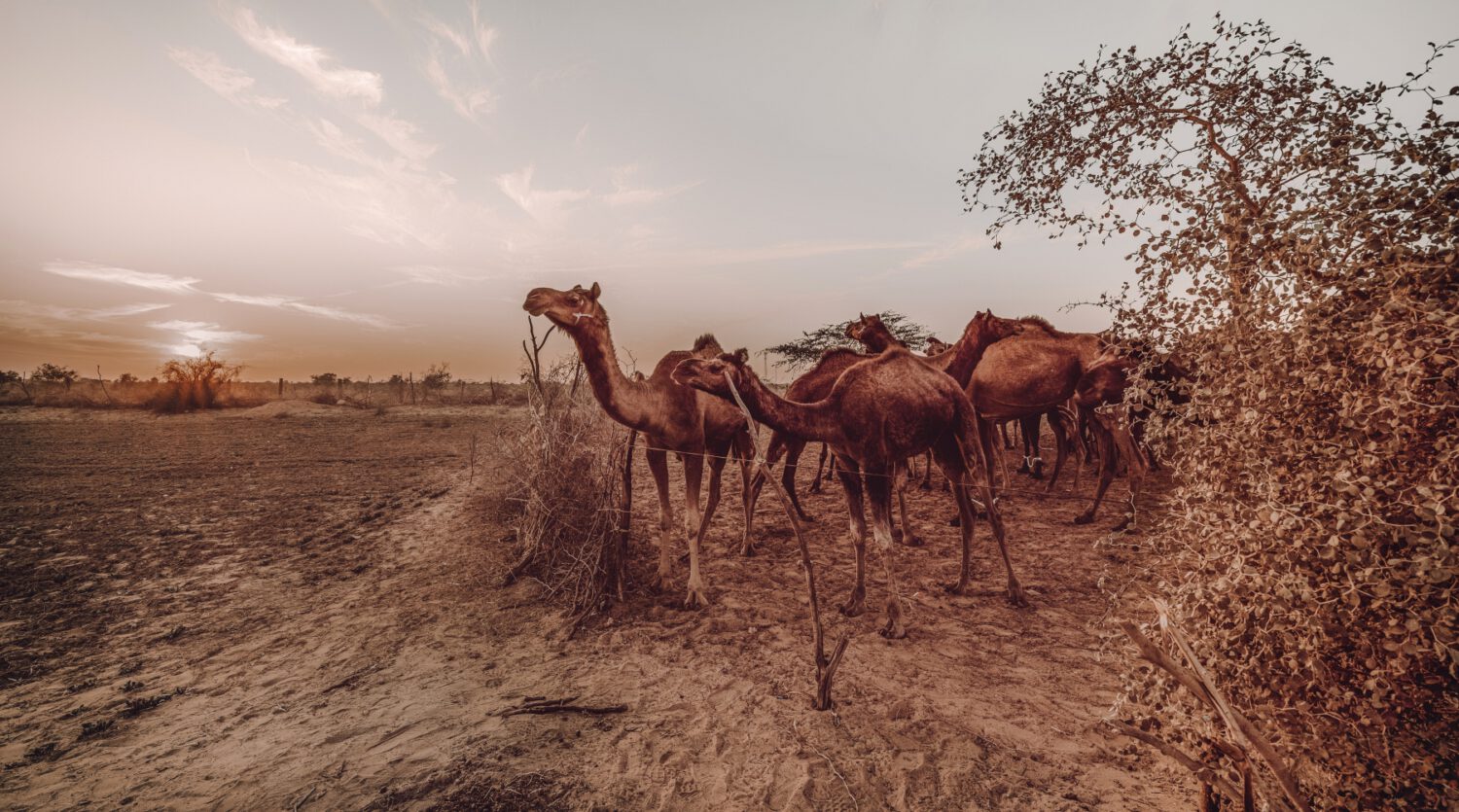
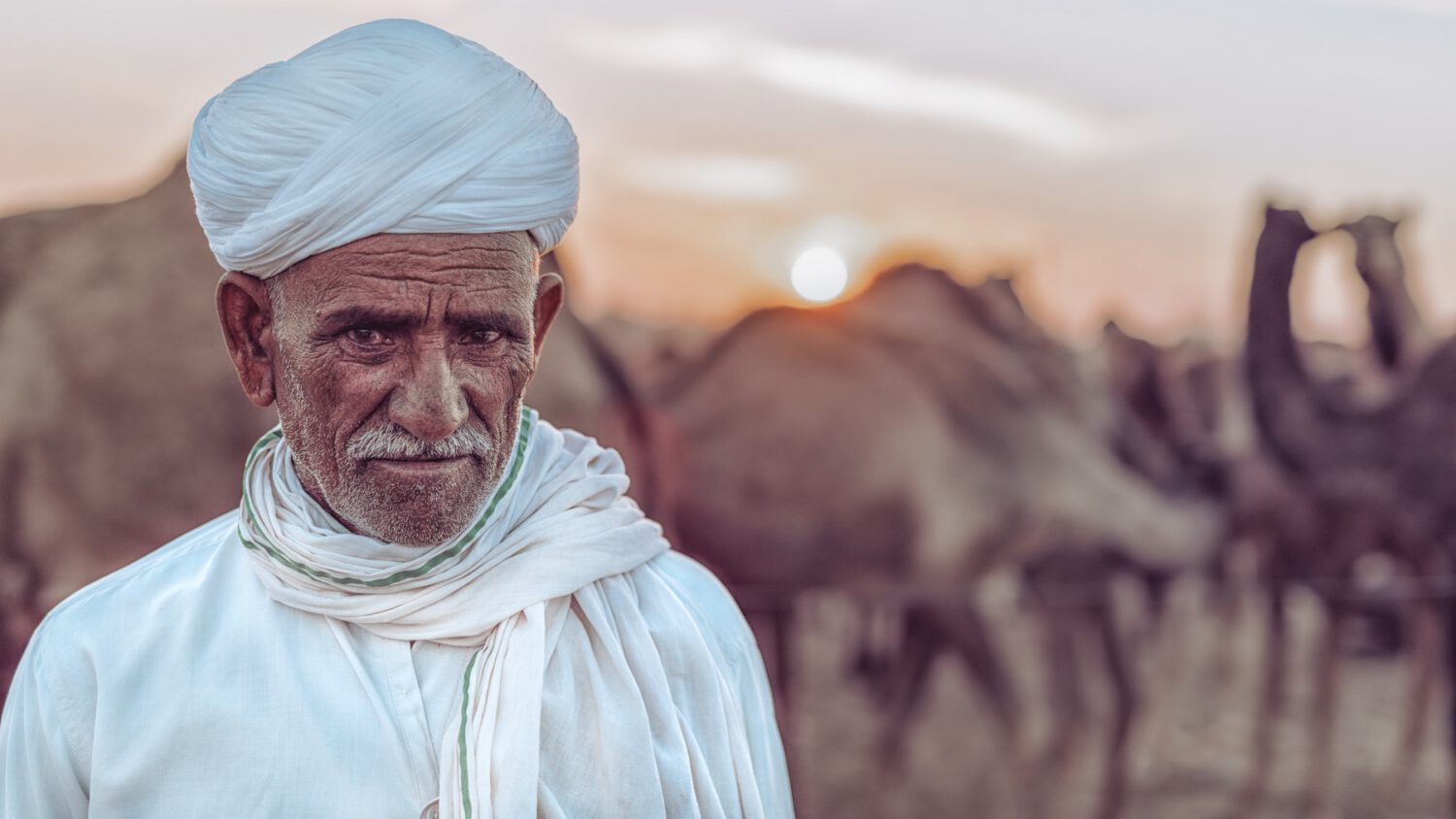
After arriving and checking in at my accommodation, I couldn’t wait to stretch my legs and definitely grab a bite to eat first. What could be nicer than visiting one of the many food stalls. Just looking at the preparation makes your mouth water. Since it was already quite late and dark that evening, I decided not to do anything else.
I had planned a very full day for the next day and so, right after breakfast, well strengthened, my first visit was to the Chandraprabhu Jain Temple. Located in the Jaisalmer Fort, it was made in 1509 AD. It is one of seven temples dedicated to the 8th Jain Tirthankara Chandraprabhu. The Rajput architecture of this temple can be seen in its intricately carved mandapa and pillars. The dome inside this temple is finely intricately crafted with delicate sculptures. On the sides of the walls, two staircases with steps carved in marble lead up to the upper level of this temple, which again gives me the opportunity to admire these incredibly artistic carvings up close.
With my walk, of course without shoes, through the interior of the temple, I quickly lose my orientation. All these handicrafts are too beautiful to admire, and I think about where I haven’t been and where I should run to. There is no hurry, so continue to enjoy the sight of these treasures and finally come to a small shrine, where a kind of temple guardian is crouching on the greasy, shiny bench, pointing and asking me to have a look at the hand-carved image of Chandraprabhu. It’s made of pure marble, and wherever you look, the temple’s pillars are inlaid with countless other sculptures of apsaras (nymphs). A kneel and a brief pause comes over me and I put a few more rupees in the small bowl that is placed on the stone floor in front of me.
Before leaving the upper level, I politely ask if I can finally take a picture of him and he immediately signals his clear yes by swiveling his head slightly from right to left and back again. Thank you for this kind gesture.

For me, traveling to the north Indian state on the border with Pakistan also meant visiting Jodpur, the second largest city in the state after Jaipur. You can imagine that my entire journey demanded a lot of effort from me. In order to fill my somewhat tighter travel plan with all sorts of different things, I also went out in the evening after a strenuous day of travel and sightseeing. I’ve always found it fascinating when life begins to pulsate in the city. The countless food stalls alone with their varied and tasty street food tempt you to try a portion everywhere. All sorts of vegetables, fruits, sweets and household goods are offered in the markets and shops. There are also small tools to be found, an imaginable amount of textiles and, not surprisingly, all sorts of different electrical items, as well as an imaginable number of handicrafts are also present.
In order to move easily between all of this, I only have my small shoulder bag with me. For my street photography I use a small body and a fast 35mm lens. Tripod is completely inappropriate for me here, which I would only take with me for very specific projects. Since I also like to look at shops from the inside, I also keep an eye out for it, and found what I was looking for here with „Jain Textiles“. It starts right in the entrance area, right, left, simply everywhere you look, endless textiles, fabrics of all kinds. It only took a short moment for an employee to notice me and immediately asked me where I was from, how I was City of Jodpur, anyway, how I liked India. This immediately resulted in a lively conversation and I was asked to come up to the 2nd floor, where the owner would be introduced to me.
There I stood and looked at a room packed with textiles and fabrics and colorfully filled, which only allowed a narrow passage between the piled up fabrics lying around and on top of each other. The shelves along the walls were of considerable height and were also stacked full, with textiles neatly laid one on top of the other, all fabrics sorted by type and colour. I was introduced to the owner without hesitation and they immediately organized a traditional Masala Chai, the Indian spiced tea, the national drink of India, which I was happy to drink. Time passed and I found out that he had already supplied fabrics for a number of fashion designers and fashion houses and also tailored models for them. It wasn’t long before he showed me a couple of magazines and fashion magazines that featured him with oddities and ends in the fashion world. I expressed my respect and the request to be allowed to photograph him in action, also after consultation with his customers who were present. Everyone seemed to like that.
For me an experience like in the Arabian Nights, that’s how I felt in any case. It was really an exciting experience of a rather spontaneous encounter, and of course also that I was allowed to take photos here. A genuine hospitality and gesture that left a lasting impression on me. Again, my special thanks to „Jain Textiles“, to whom I have of course already sent my recordings.

In the winding streets of the city you will find all kinds of consumer goods, such as handmade raffia baskets of all sizes. The whole family gets involved here. After school, just like on weekends, it is common for the children to be part of the action. They weave and sell. Everyone contributes to the joint income to make ends meet.
The same applies to the spice shops that can be found on every corner. The colorful variety of Indian cuisine is neatly presented. In addition to coriander, cinnamon, curries, masalas, ginger, cardamom and chilli, just to name a few, you can get sweets, savory things like fried banana slices, biscuits, cigarettes and drinks. Everyone is proud to help out in the family business.
Anyone planning a round trip to Rajasthan, a state in the north of the subcontinent, will certainly want to visit the desert city of Jaisalmer on their route, even if it is a bit off the usual route.
The Golden City alone enchants and beguiles with its unmistakable charm. From afar, when the sun is high in the sky, the outline of the desert city appears on the horizon like a mirage. Sand-colored walls of the houses and of course that of the impressive Jaisalmer Fort amazed me. Especially at sunrise and sunset, an extraordinary and fairytale cityscape emerges.
In the fortress, which can only be entered through a huge entrance gate, a labyrinth of narrow streets leads to every corner of this fabulous city palace. You will hardly find your way around without a guide. However, if you explore the fortress on your own, you can be sure that the inhabitants of the fort, there are around 3000 people who have lived here for generations and offer everything in countless small shops and shops, as well as on a market in the fort makes the visitor’s heart beat faster, will help you in the most friendly way.
Just as I met this woman here at the market, elegantly dressed in a traditional sari, who not only understood that I wasn’t buying anything from her, but also allowed me to take this picture of her. Thanks a lot for this.
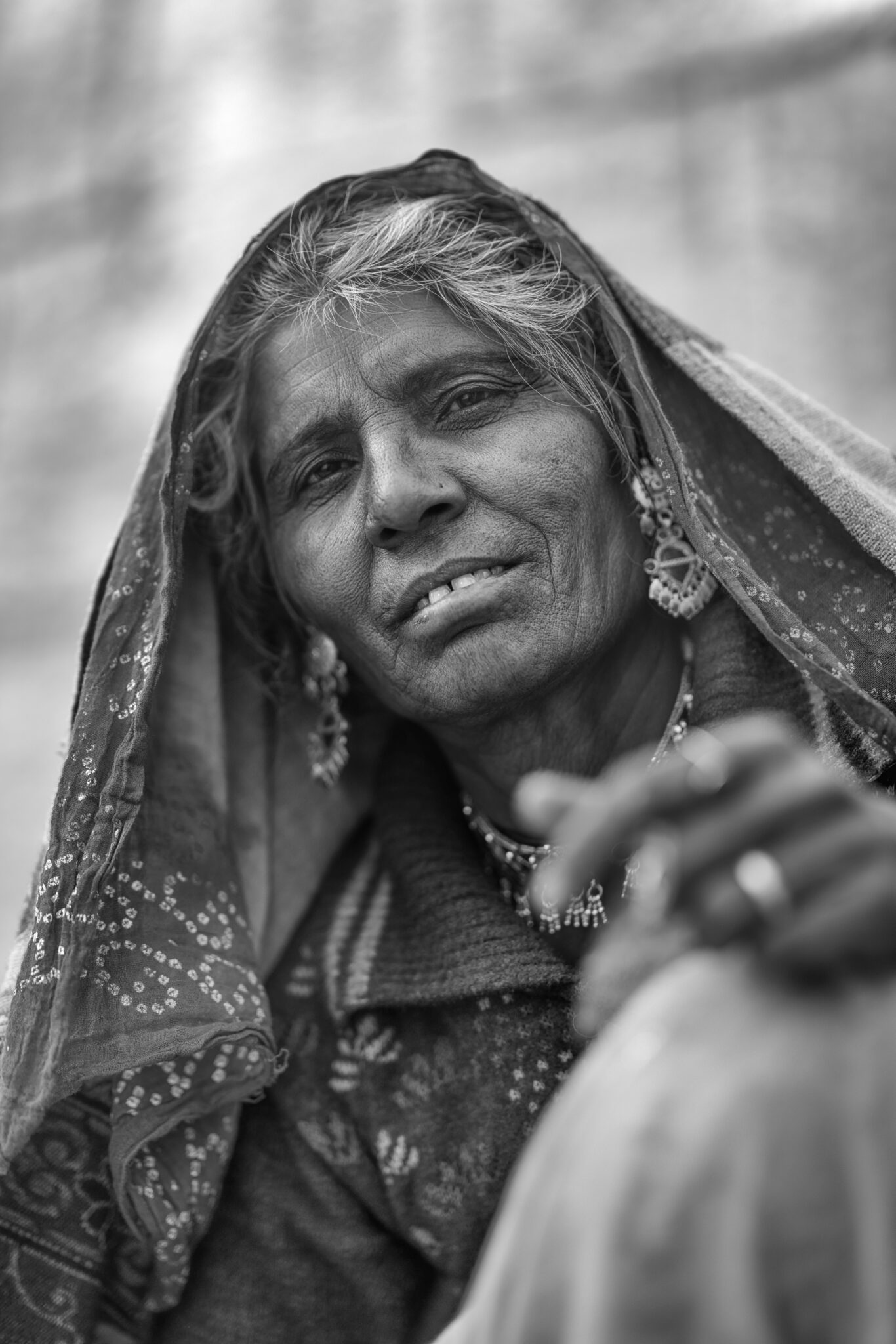
On the way in the desert city of Jaisalmer, it was always possible to talk to the locals. Just like with this woman, who sat with her neighbors in front of their house entrances and chatted animatedly. A moment of exchange ensued when I inquired about directions to Jaisalmer Fort. She must have guessed that I wanted to go there and showed me the way.
I thanked her and pointed to my camera briefly, then to her, and without saying a word she shook her head sideways, agreeing to be allowed to take a picture of her. So did I, in a very brief moment of absence.
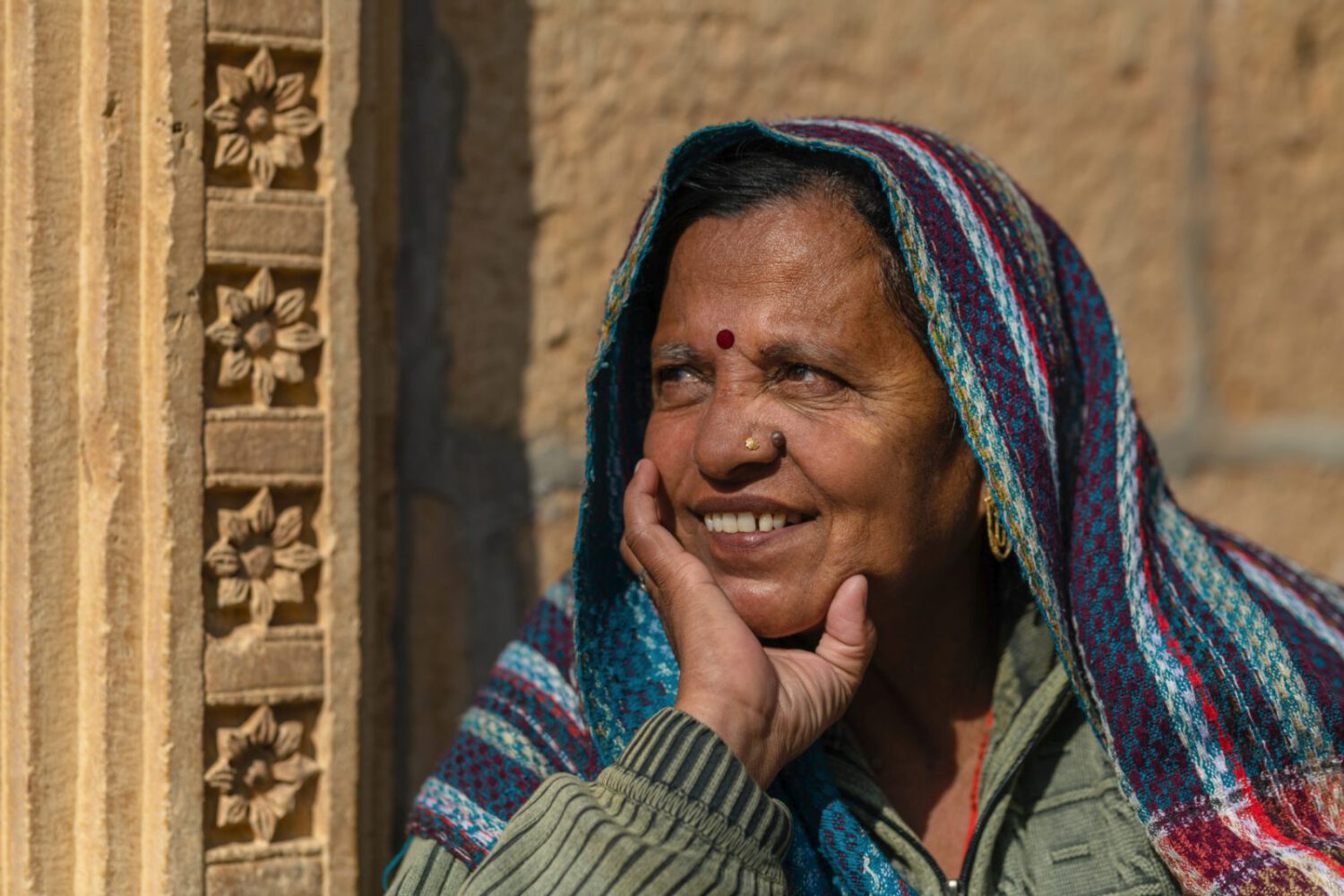
Around 3,000 people live in the historic core of the old town of Jaisalmer Fort. A number of families have been running their small businesses for generations, lined up in the narrow alleys of this labyrinth, between a narrow little house, often suddenly appearing out of the blue. Criss-crossing, back and forth, wherever you go, it was immediately clear to me that walking here alone would automatically mean getting lost.
As soon as the morning awakens and the first preparations are made for the upcoming tourism that will visit the fort that day, life in the narrow streets gradually begins to awaken.
The sun is smiling, reason enough to meet outside on the street for a chat. There’s sure to be something new to tell, and nothing easier than that, a chair is quickly organized and you’ll find a place to linger, regardless of how pulsating life in the fort will begin later.
Once again I am impressed with the serenity with which people live their day here.
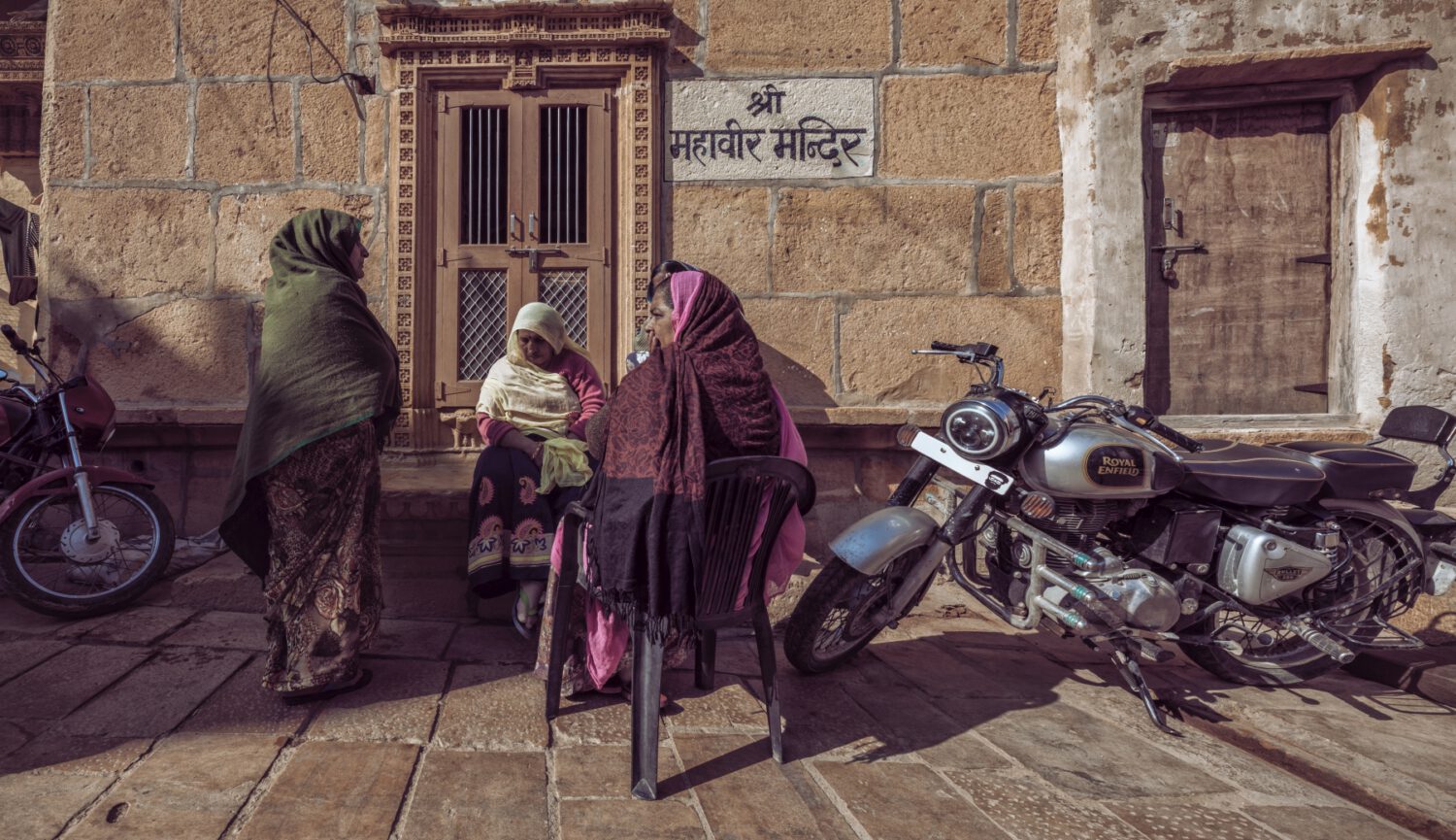

With my tour guide Satish, who I had organized for the day in advance, I visited the fortress of Jaisalmer, Rajasthan, which was founded in 1156 and is truly majestically enthroned on a hill above the city. Seen from a great distance, this imposing structure, built entirely of sandstone, with its 500m length and 250m width, rises almost like a surrealistic painting from the barren landscape that surrounds it. On some days the fort is shrouded in damp fog and hazy air. Then it is impossible to capture this architectural masterpiece in all its splendor and dimension. But when the weather is at its best and the air is clear and dry, the fort suddenly nestles between the blue sky and slightly brownish desert sand in such a way that the thought can quickly arise that the second oldest fort in Rajasthan is a fairy tale sprung.
From our meeting point, our walk took us up a fairly uphill cobbled path, straight to the oversized iron-studded hardwood, also called the Gate of the Wind, the main entrance to the fort. I was surprised to learn that the fort has been inhabited for generations by numerous families who now make their living mainly from tourism. My very pleasant tour guide lives here with his family, which impressed me incredibly, and since the several-hour walk through the huge fortress is not without it, he invited me to his place for tea later.
We roamed through the maze that was so confusing for me, which consisted only of narrow streets. In life I would never have known where I was, let alone found my way back to the exit. But that thought was quickly gone. I preferred to watch the beginning hustle and bustle, although only a few people were out and about. Around noon, I was told, it would get incredibly crowded. So I was well advised to be here as early as possible. Along the narrow paths, friendly, smiling traders stood in front of their small shops and offered me all sorts of souvenirs as I passed, which I refrained from doing. Firstly, because I’m not a souvenir hunter myself and secondly, I’m very careful about the weight of my luggage, as I also made a few domestic flights. There is a very careful inspection and weighing. Each illegal kilo costs the equivalent of around €35.
Arriving at his sandstone house, I immediately noticed the front of the house painted with portraits and characters, as well as the purple painted wall of the neighboring building. What an eye-catcher, a sturdy ocher-colored front door decorated with flat iron and the natural-colored stone tiles in front of the house, seemed massive and solidly built, very attractive and comfortable. The hanging clothes lines that were stretched here and there served their purpose sensibly and extensively.
It didn’t take long before his wife came out of the darkened entrance area, followed by their children. Very Indian, I clasped the palms of my hands together, close to my heart, placed on my chest, bowed my head slightly and greeted them with a hearty „Namaste“, which literally means „bow to you“. Which she immediately replied. She went back into the living room to prepare some tea that her husband had requested for us. I was shown around the house and then we were served hot tea outside, which we enjoyed with lively conversation.
Finally, I was allowed to take some pictures of everyone. That and my visit to you made me particularly happy. Many thanks to Satish for his friendly and interesting way of personally introducing me to the life and history of Jaislamer, including visiting him and his family.
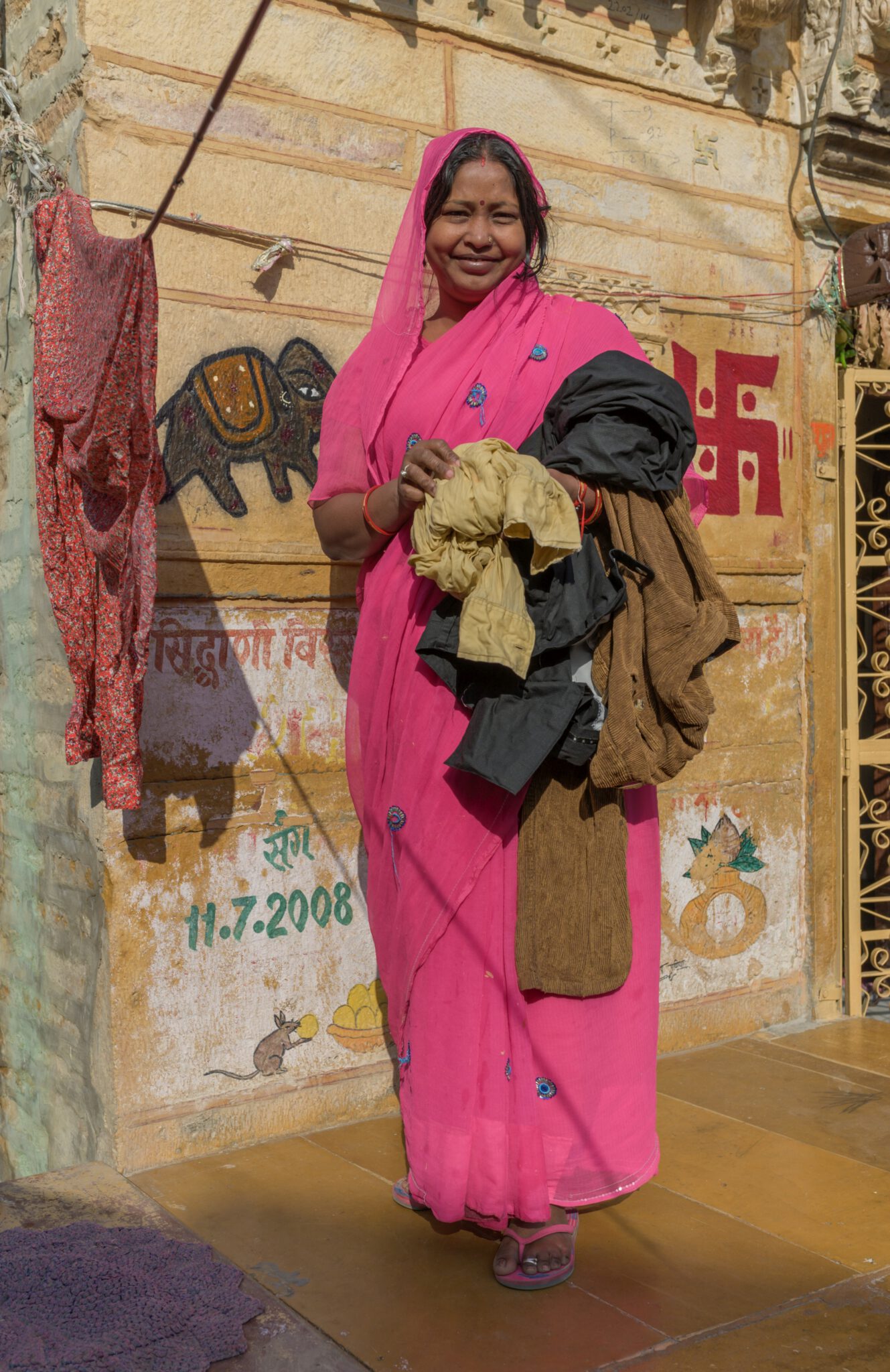
On my way from Agra to Jaipur, we overtook this remarkable motorcyclist who, fully laden with carpet and his many balls of wool, rode adamantly against the wind.
When I saw him next to me, I liked the scene so much that I asked my driver to slow down a bit so that the biker on his Hero could easily pass us. No sooner said than done…..then I took this snapshot.

Agra, the city in the northern Indian state of Uttar Pradesh, where the world-famous Taj Mahal, a mausoleum, was built by the Mughal Emperor Shah Jahan for his wife Mumtaz Mahal, who died in childbirth in 1631, is a must for every visitor to Rajasthan for the first time traveled There are also many other sights in the city, but it should not be underestimated that they are all well visited. The Taj Mahal alone is visited by around 4 million tourists every year.
On the one hand, of course, I am also interested in these sights, without a doubt, but if it gets too crowded for me, I make sure that I move a bit away from them from time to time. Which I did after visiting the Taj Mahal, Red Fort and Itimad-ud-Daula Mausoleum.
It just went into the city, which with its almost 2 million inhabitants is not exactly a haven of peace. It’s lively and lively here. Everything is mixed up all over the place. Whether cars, bikes, bicycles, rickshaws and carts that are being pulled behind you or, as shown here, the man who has to make his way through the crowd with his fully loaded tricycle tirelessly and with the greatest physical exertion.
All of this speaks for an incredible background noise, because hardly a moment goes by without the horn being honked. Everyone wants to get ahead, so the scope for a certain amount of consideration is rather modest. But it works. As a rule, very few accidents happen here, because everything drives around the other skilfully. Worse are confusing overtaking maneuvers or worn tires, such as brakes that don’t work properly.
Here you are well advised to walk. There is a rickshaw on every corner. For a few rupees the driver will take you anywhere. It is advisable to ask for the price or to make it out. In the meantime, my driver went out to eat and I started walking without really having to find my way, as I later took a rickshaw to bring me back to my accommodation anyway.
Street scenes of everyday Indian life have always fascinated me. Here you will find not only modern means of transport, but also traditional and ancient locomotion and transport, which meet in a small area. The incredible dynamic that I tried to capture here is omnipresent and shows once again how close together, traditional and modern exist and, above all, function
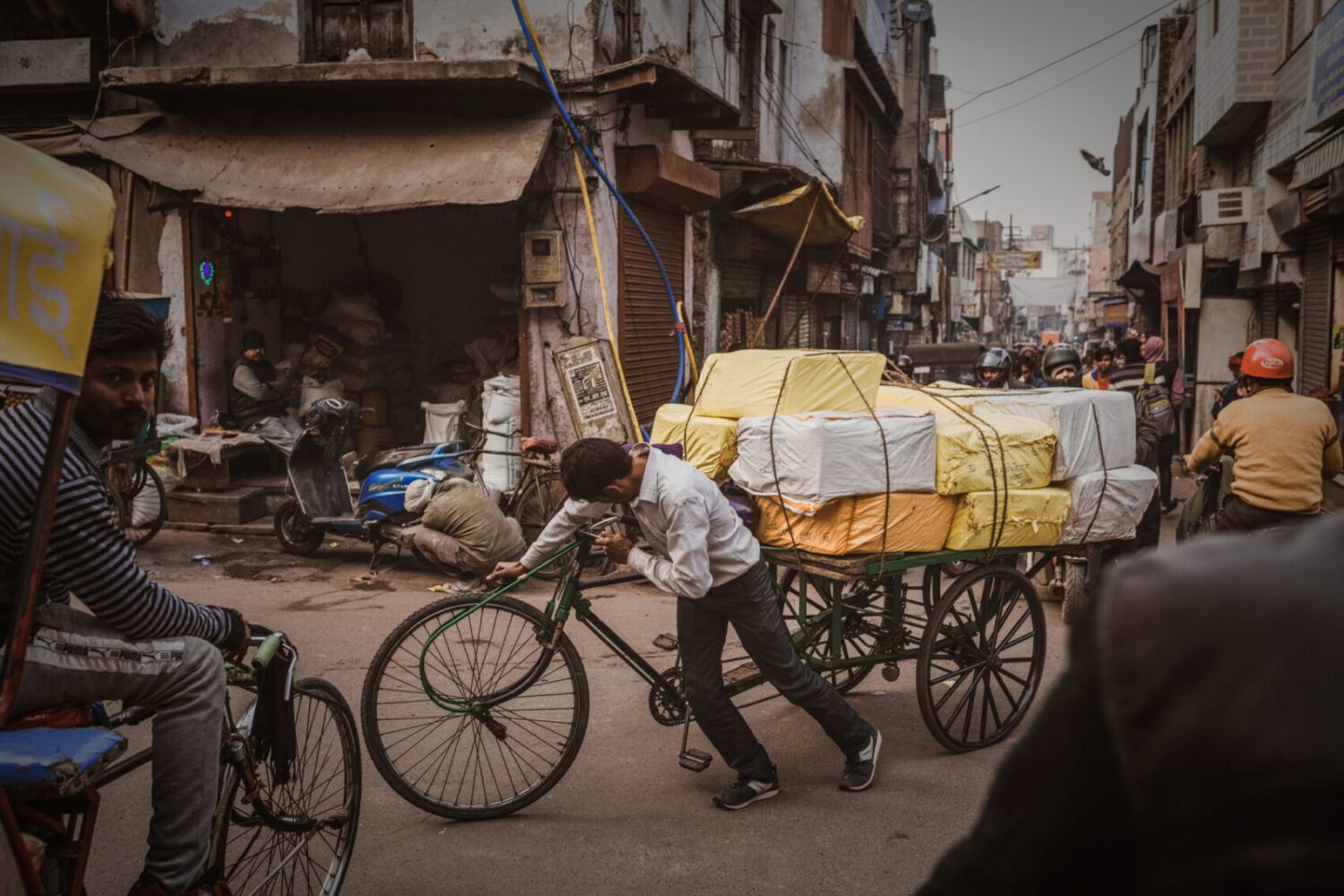
The long drive from Jodhpur to Udaipur is about 270 km, with a few stops along the way, it took us a good 8 hours. That made you hungry. Immediately after checking into my accommodation, I set off again with my driver, of course with a camera.
What is so uncomplicated and, above all, tasty in India? The food stalls. There are countless food stalls in the cities that offer everything boiled, roasted, deep-fried, grilled or roasted.
Anyone who, like me, has found a treat for the palate will certainly want to try most of them. The quick preparation and the high demand speak for themselves. I’m just saying, just turn it on and let yourself be surprised and, above all, enjoy it. Enjoy your meal !
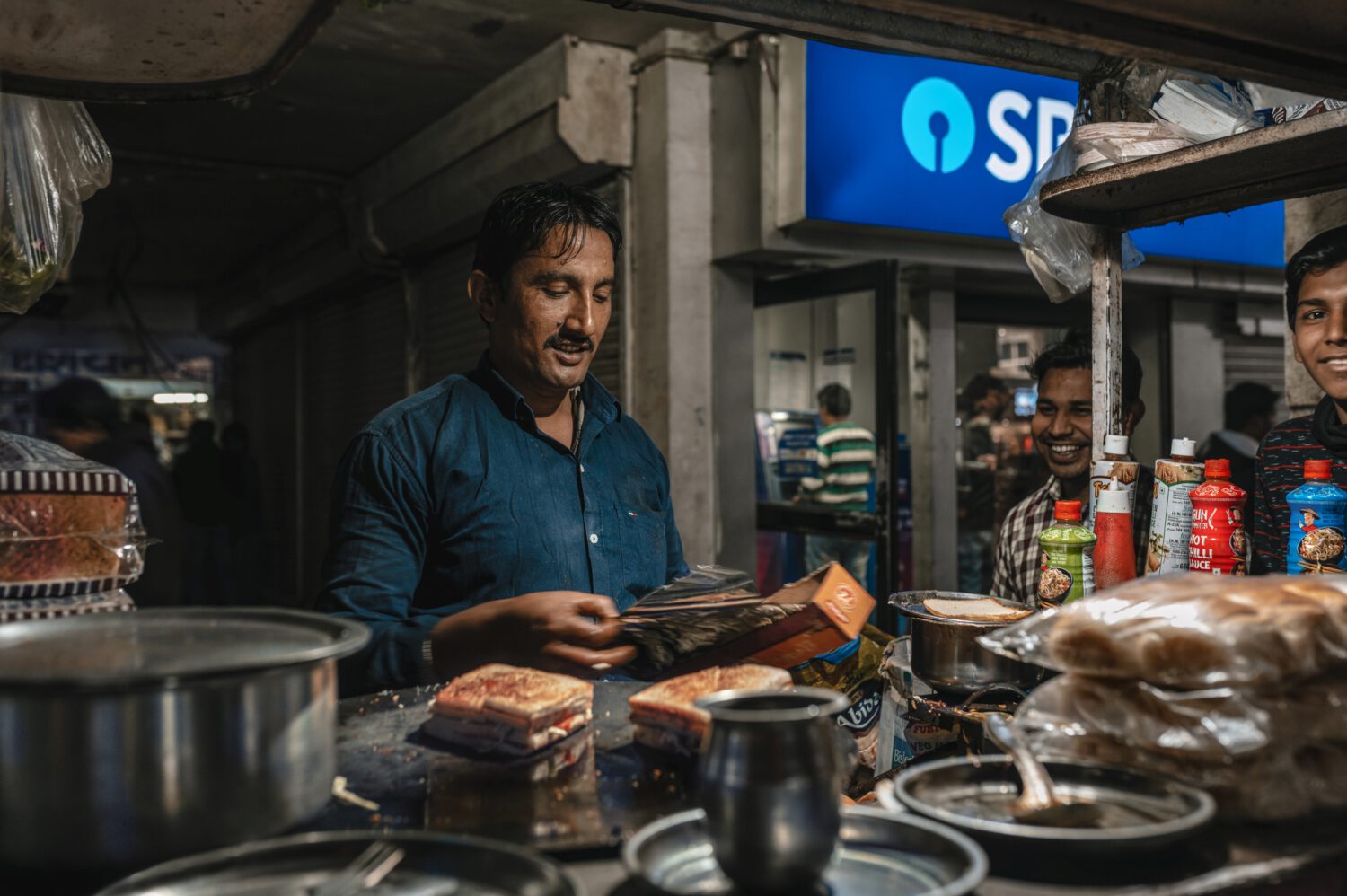
In Udaipur there are magnificent palace complexes in a landscape criss-crossed by lakes, which made this city famous as the „Venice of the East“. Films such as „The Tiger of Eschnapur“, „The Indian Tomb“ or „James Bond – Octopussy“ with Roger Moore all used the unique backdrop of Udaipur and certainly contributed to its worldwide fame. The best way to explore the lively streets of the old town is on foot. Because pure life awaits you around every corner. Colourful, diverse, lively, but also relaxed and romantic. You can experience brisk activity everywhere. It’s the small food stalls that offer every imaginable edible thing that is prepared right in front of your eyes. My recommendation, only eat a small portion at a time, I think it’s a shame if you don’t try the many delicacies that everyone offers here. A pure culinary delight can be experienced here and I catch myself again and again letting some people pack a small extra portion to take away.
Everything from groceries to cooking pots, wool, carpets, clothing, household items and tools can be found in countless small shops alternating with food stalls, spice stands, restaurants, hotels and of course barber shops everywhere you look. Colourful, lively and incredibly varied, this is how visitors experience the city, which is also known as the “most romantic city in India”.
I love getting in touch with the local people. So I discover this inconspicuous little bakery between the many inconspicuous houses. Curious and interested, I stopped in front of the bakery and found out that bread was baked here. More precisely, Indian naan, a flatbread made of wheat without yeast, which is an indispensable part of Indian cuisine. A job that, one might think, is easy to handle. Speaking against it is not just squatting for hours on end. With the simplest means, precise manual dexterity and skill, the dough is kneaded, formed and finally baked in order to be sold at a nearby market. Modest wages beckon for a 10-12 hour working day. Six days a week. Before I said goodbye, I was kindly allowed to take this picture.
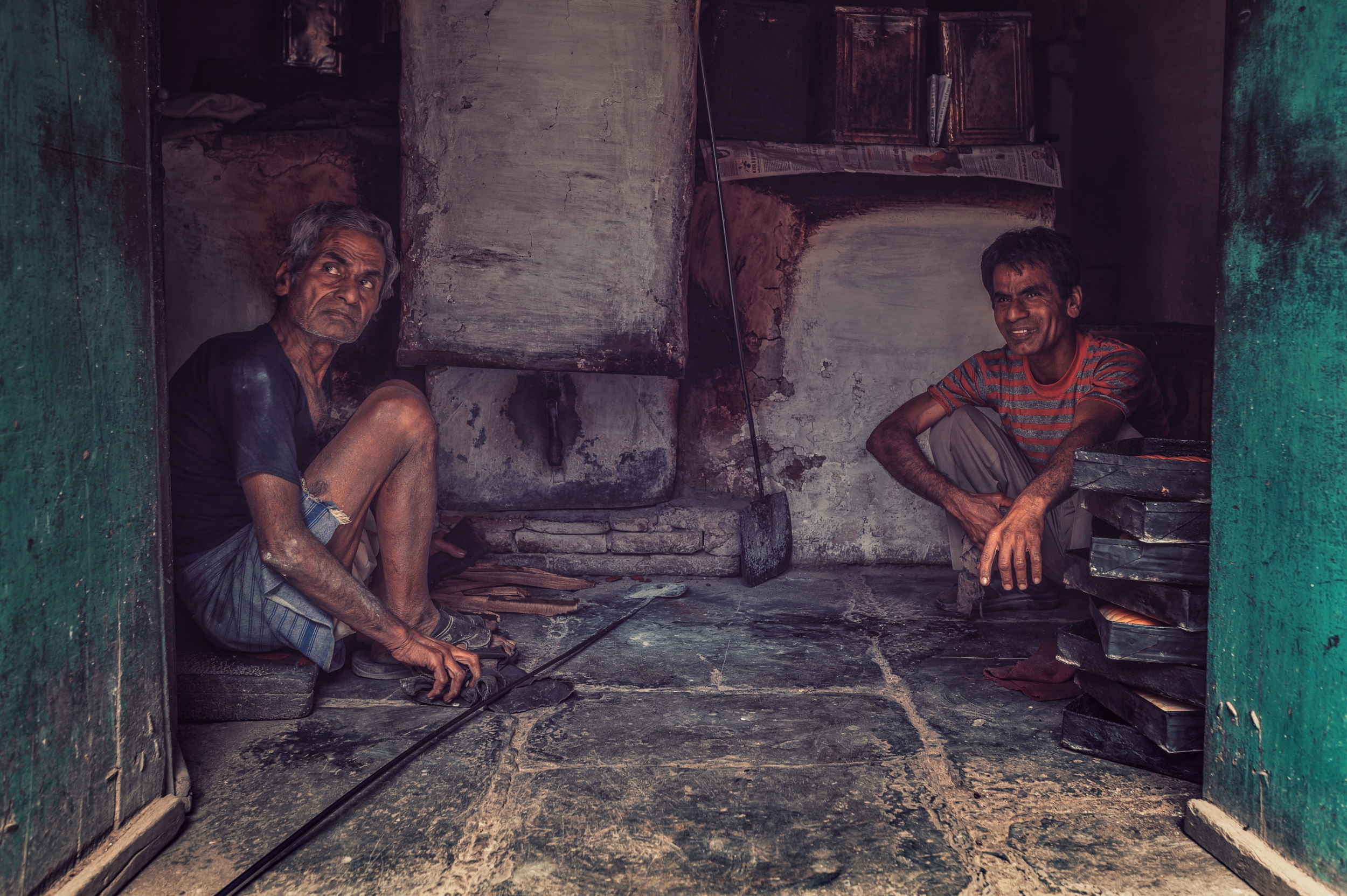
I like to be on foot, like here through the narrow streets of the city of Udaipur, Rajasthan, to get a first-hand feeling of the people and the atmosphere and, of course, to keep an eye out for suitable motifs.
I love getting in touch with people to ask questions, to exchange ideas, just as I discovered this potter and immediately greeted him and introduced myself. I found out that he makes pottery every day, that he learned the craft from his father and that his son is now following in his footsteps.
A job that, one might think, is easy to handle. On the other hand, not only squatting for hours speaks against it. A lot of work has to be done, with the simplest of means, precise dexterity, skill and a large portion of concentration. Something for everyday use is made here with a lot of effort. It takes time for the clay bowls, mugs, plates and jugs to be shaped and then fired in the oven. They are sold at a market nearby to earn a modest wage for himself and his family.
In between I was allowed to take a few pictures of him and his work. Thank you for this friendly encounter.
Thanks to an Indian friend who picked me up in his car in Mundakayam, where I was visiting friends for a week, to drive to the city of Munnar, which is 160 km away to visit its fantastic surrounding mountain region, which is famous for its tea plantations.
Our goal was to drive past a number of tea plantations to the Mattupetty Dam, which is not far away. Around the local attraction, there were a few smaller stalls that offered classic souvenirs or just drinks and all kinds of edibles.
So I noticed this elderly gentleman a little away from the hustle and bustle, how he was sitting in his small wooden shed, looking out of his shop. There really wasn’t much to buy here. He had bottles of water and cigarettes to offer. So I asked for a bottle of water and my friend for a single cigarette, which is customary everywhere in India.
From the beginning I was fascinated by his charismatic facial expression and the strong gestures with which he spoke to my friend in the local language. My English didn’t get very far here and I certainly don’t speak Malayalam, which is spoken in Kerala. I can manage a few words, which is just enough to say hello, say goodbye, thank you or just ask how well you are. English is the official language in India. The Indian constitution recognizes around 20 main languages, and a further 100 languages are spoken throughout the country. These and innumerable dialects indicate the extreme linguistic diversity with which the 1,350,000,000 people across the country meet.
So we exchanged ideas with the help of translations and I found out that he had had his small shop here for over 20 years and must be around 80 years old by now, which he can no longer say exactly. He asked where I came from and how I would like it here. I told them enthusiastically that I had enjoyed visiting India for many years and that I felt very comfortable here.
Last but not least, I asked if I could take a picture of him. His friendliness and obvious gestures spoke for themselves and while both of them continued to talk undisturbed, I was able to take a portrait of this person, who was perceived as charismatic, without being intrusive. My special and lasting impression that I was allowed to take home with me.
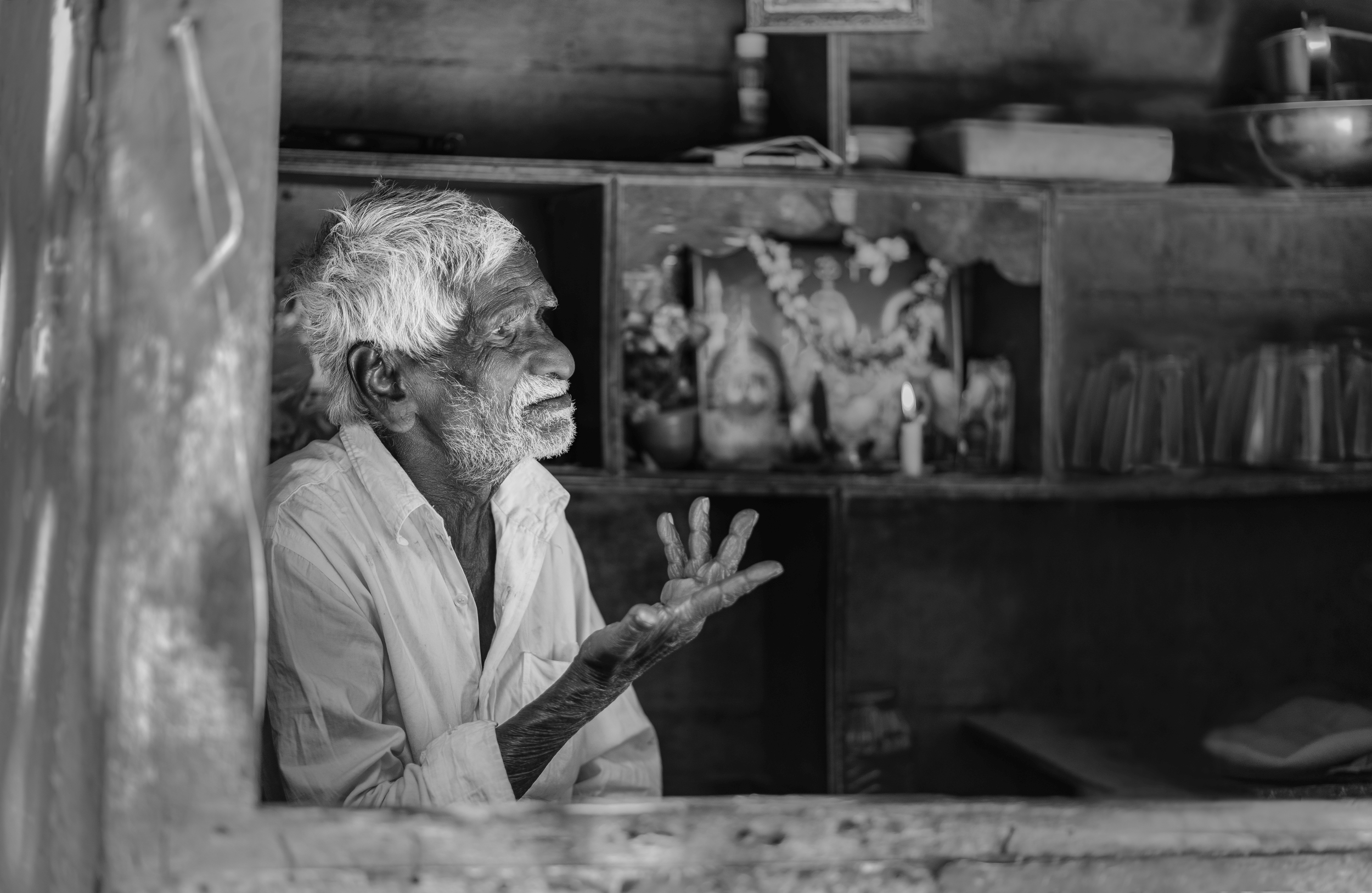
Munnar is a smaller town in the Western Ghats mountain range in the Indian state of Kerala, 1524 m above sea level. It now has around 40,000 inhabitants and appears very lively when you arrive there, which is completely normal for returning foreign visitors. A number of tourists, both local and foreign, love to visit this region.
As far as the eye can see, there are numerous tea plantations that were created in the 19th century. Munnar, known as the Queen of the Mountains of Kerala, offers a wonderful cool, around 20-25 degrees. At night the temperatures sometimes drop to 5-7 degrees. More and more tea is picked by machines, partly because of the economic efficiency, but also because the plantations are huge. Nevertheless, there are also a number of small plantations where the tea is still picked in laborious and patient manual work.
It was important to me this year on my trip to visit Munnar to also get some regional shots like this one. A stop at the side of the road and I quickly got into conversation with the people. It’s unbelievable how much tea has to be picked by hand to load this truck. I was told that this plantation had to do without any machines. The sacks filled with tea leaves are weighed and loaded, after which the wages of the tea pickers are calculated, which unfortunately still turns out to be very modest.
As soon as I arrived during the day, I was very impressed by this dreamlike landscape of tea plantations stretching out into the country, which stretch to the feet of the mountains behind them.
What a joy I felt at the thought of hopefully finding a suitable location. But before that, we started looking for a suitable place to stay. Since we arrived on New Year’s Eve, you can imagine that many accommodations were already fully booked. Even my friend’s connection seemed exhausted until, luckily, we got a recommendation. A few kilometers outside, in a very quiet and almost isolated location, we found our hotel, which was fine with us. Munnar was just now at this time of year, especially at the turn of the year, filled with tourists and seemed rather loud and lively. We, on the other hand, found an exceptionally beautiful and very comfortable place to stay, which also had friendly staff and courteous hoteliers.
After checking in and freshening up, we first went to eat, it was only early afternoon, and then made our way to a suitable vantage point, which we found out from our nice hotelier. Even if it was less than 10 km away, we still had to plan a longer journey time, solely because of the damage to nature and roads caused by the extreme rainfall last year and which has not yet been completely repaired. The endless and completely battered road meandered only with difficulty to our intended vantage point. We arrived in time to set up the tripod and camera. Now all we had to do was wait. It was good that we had thick jackets with us. The temperatures were already at 7 degrees in the evening, which was nothing unusual in the already cool region. So we patiently enjoyed this view until the sunset made our hearts beat faster and rewarded us accordingly.
As far as the eye can see, there are numerous tea plantations that were created in the 19th century. Munnar, known as the Queen of the Mountains of Kerala, offers a wonderful cool, around 20-25 degrees. At night the temperatures sometimes drop to 5-7 degrees. More and more tea is picked by machines, partly because of the economic efficiency, but also because the plantations are huge. Nevertheless, there are also a number of small plantations where the tea is still picked in laborious and patient manual work.
It was important to me this year on my trip to visit Munnar to also get some regional shots like this one. A stop at the side of the road and I quickly got into conversation with the people. It’s unbelievable how much tea has to be picked by hand to load this truck. I was told that this plantation had to do without any machines. The sacks filled with tea leaves are weighed and loaded, after which the wages of the tea pickers are calculated, which unfortunately still turns out to be very modest.
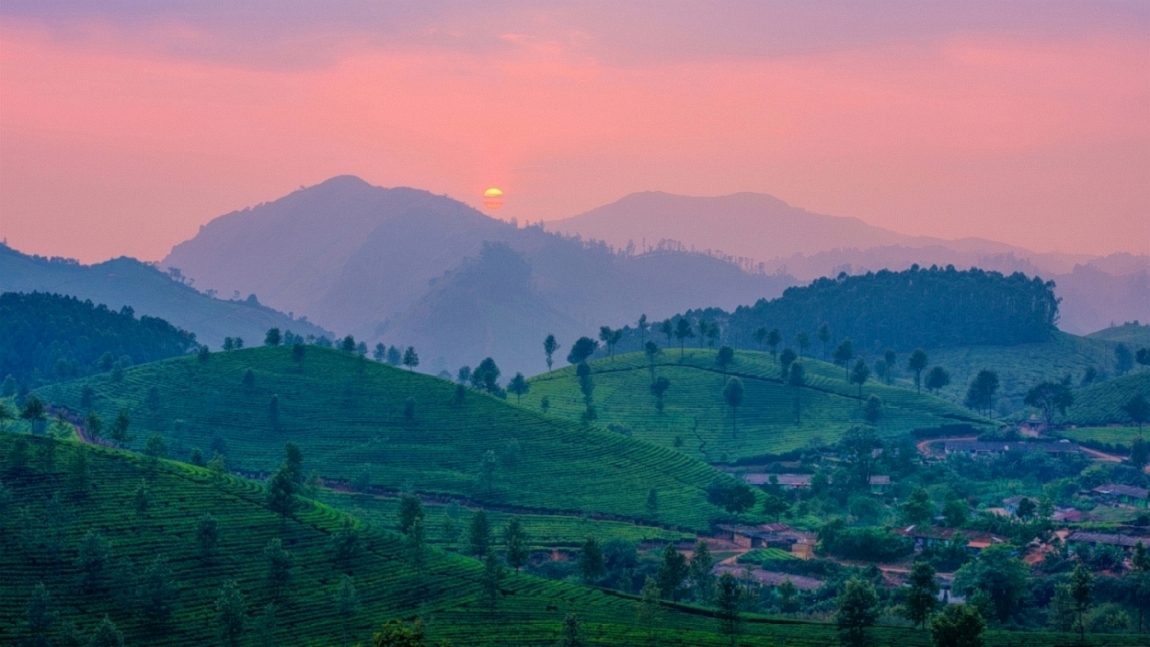
It is a special privilege to have your own garden, if only because you can plant all kinds of vegetables and spices there and harvest them as needed.
Mary is lucky that her son owns quite a large piece of land. There are mainly rubber trees as far as the eye can see. If you look around, you will also discover a number of pepper tendrils, coconut palms and banana trees. Fruits such as mango, papaya, yak fruit, pineapple and spices can also be found. Last but not least, chilli bushes should not be missing.
What is also in the ground, we see here, the yam root. A type of vegetable similar to a starchy sweet potato. A robust brown skin on the outside, the flesh is whitish to pink on the inside.
It takes a lot of effort and skill to get this bulb out of the ground. Her husband Joseph supports her and uses a hoe to penetrate deep into the ground to get under the tuber, which is then practically levered out. Once the root is exposed, excess soil is removed as much as possible. This tuber here in the picture must have weighed 7-8 kg. Just the thought when looking at this work conveys that this is hard and strenuous work. You have my fullest admiration. Mary has been a tea picker at Vandiperiyar Tea Estate for over 40 years, 6 days a week.
In the kitchen, the tuber is meticulously cleaned, peeled and cooked. A rather spicy chicken curry and bean vegetables are prepared for this. For me it has to be spicy, that’s how I love it. Original as it is eaten in India. Again, I am amazed at how quickly everything is done and with what dedication everything is served to the point for the whole family in the evening. Then this taste….simply excellent. Mary’s cooking skills are just a real treat.
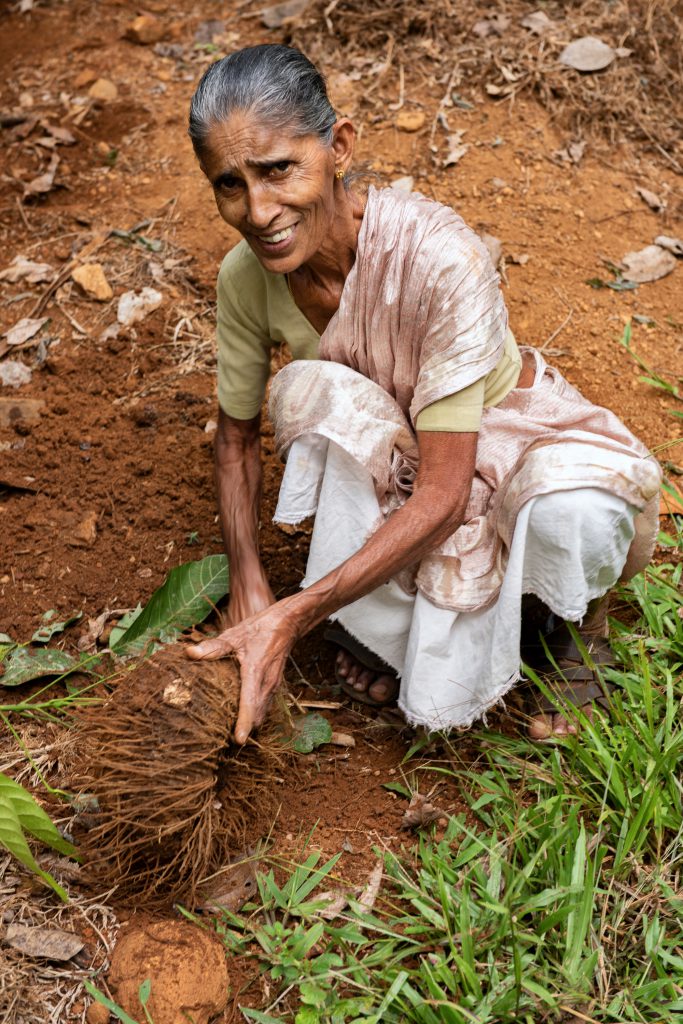
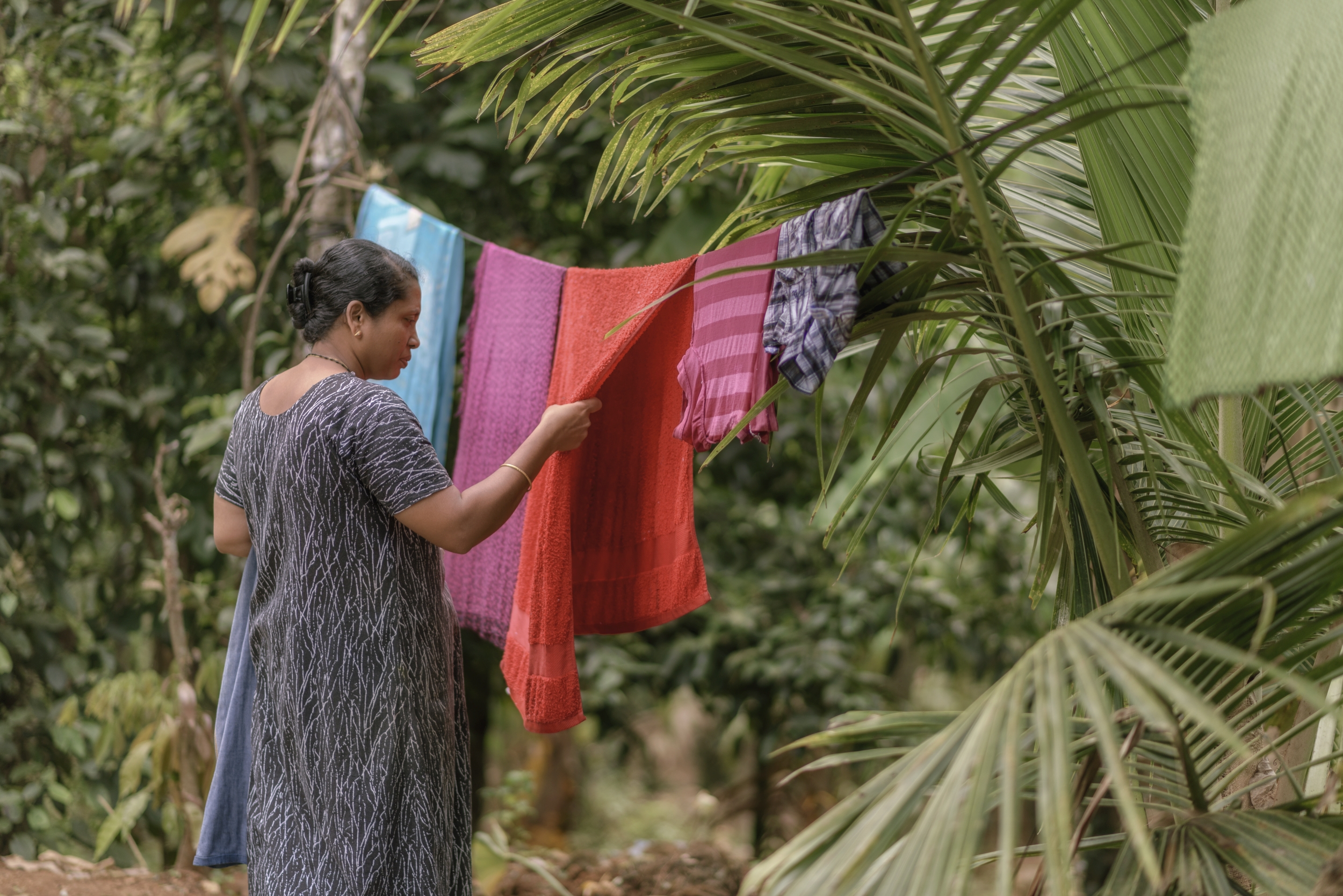
When it comes to work like this, digging up such huge yams, it takes not only skill but also enough stamina and a lot of strength. Joseph was tireless and fought until this root was finally exposed. Just the sight of what was revealed blew my imagination and made me sweat just watching it. The weight of this root was a real challenge even for Joseph, also because of its unwieldy nature, which he, however, could not manage alone. The two of us finally managed to get the fruit behind the house, where Mary cleaned and peeled it. The root then found its place in the kitchen for further processing and was able to simmer in peace until the tasty and plenty of hot curry, with chilli and masala, a spice mixture according to a traditional recipe, which Mary prepared from her mother got the way, done. The curry is either chicken, lamb, beef, fish or just boiled eggs as a basis. Papadam, a thin fried flatbread made from lentil flour that is baked in oil and puffs up like a puffer fish, is often served as an accompaniment. Delicious just dipping this kind of bread in such an aromatic and flavorful curry.
For me, this meal was again a poem for my palate and despite the sharpness, I always manage to taste individual spices such as ginger, cardamom, coriander, turmeric, pepper or amchoir.
By the way, another important note about eating in India. It is mainly eaten with the fingers and only with the right hand. In India, the left hand is only used for hygienic purposes and is therefore considered unclean. Another reason not to touch anyone with your left hand or to serve food with it.
Going to Thiruvananthapuram City, Trivandrum for short, in the capital of Kerala, is undeniably a bit of a challenge. Even if Trivandrum, with its almost 800,000 inhabitants, does not play in the league of Mumbai, Delhi or Calcutta, Trivandrum nevertheless offers a certain example of narrowness and abundance, as it is at home everywhere in the densely populated towns and cities of India.
It’s lively and loud, horns are honked like crazy. When people start counting at traffic lights, which meanwhile almost everywhere in Asia the countdown begins backwards from 20, everyone rushes ahead at the latest at zero in order to get across the wide streets. Anyone who is not ready to start now will perish. The oncoming race towards each other, skilfully past each other without even colliding in any way. Not that accidents happen, but compared to the density and driving style, amazingly rare. And if you are really brave, you can even prance from the side through the dense stream to the other side of the street.
For years now, the view has been even more clouded by dense smog than I remember from my first trip to India in 1988. Today, being on foot in the city is like a constant evasive manoeuvre, so the rickshaw drivers with their tuk-tuks can be found on every corner, a welcome alternative for getting ahead. Ideally for me, it’s a mix of both. So I stretch my legs and experience the people, the atmosphere and everyday life in the city up close. Ideal to capture something with the camera.
